

How to Write a Good Conclusion Paragraph (+30 Examples)
A good conclusion paragraph is the lasting impression you want to leave with your reader.
Here is a quick summary of how to write a good conclusion paragraph:
Write a good conclusion paragraph by summarizing key points, restating your thesis, and providing a final thought or call to action. Ensure it wraps up your main ideas, reinforces your argument, and leaves the reader with something to ponder.
This ultimate guide will walk you through the steps to craft an effective conclusion, along with 30 examples to inspire you.
5 Steps for Writing a Good Conclusion Paragraph

Table of Contents
There are five main steps to writing a good conclusion.
Let’s go through each step
1. Understand the Purpose
The conclusion is your final opportunity to leave an impact.
It should tie together your main ideas, reinforce your message, and give the reader a sense of closure.
Wrap Up Your Main Ideas
The conclusion should succinctly wrap up the main points of your writing. Think of it as a summary that captures the essence of your arguments without going into detailed explanations.
This helps reinforce what you have discussed and ensures that the reader remembers the core message.
Reinforce Your Thesis
Your thesis statement is the foundation of your writing.
In the conclusion, restate it in a new way to reinforce your central argument. This reminds the reader of the purpose of your writing and underscores its significance.
Give a Sense of Closure
A good conclusion gives a sense of closure to the reader. It signals that the discussion has come to an end and that all points have been addressed. This helps the reader feel that the piece is complete and that their time was well-spent.
Leave the Reader with Something to Think About
The best conclusions go beyond merely summarizing the content.
They leave the reader with a final thought or reflection that stays with them. This could be a call to action, a prediction about the future, or a thought-provoking question that encourages further reflection on the topic.
2. Summarize Key Points
Briefly summarize the key points discussed in the body of your text.
Avoid introducing new information. This helps the reader recall the main ideas.
Brief Summary
The summary should be concise and to the point. Highlight the main ideas discussed in your writing without going into detailed explanations. This helps refresh the reader’s memory of your key points.
Avoid New Information
Introducing new information in the conclusion can confuse the reader. The conclusion is not the place to present new arguments or data. Stick to summarizing what has already been discussed.
Recall Main Ideas
Summarizing the key points helps the reader recall the main ideas of your writing. This reinforces the message and ensures that the reader takes away the most important information from your piece.
“In conclusion, adopting sustainable practices, reducing waste, and promoting renewable energy are essential steps towards a greener future.”
3. Restate the Thesis
Restate your thesis in a new way. This reinforces your argument without sounding repetitive.
Restate, Don’t Repeat
Restating the thesis means expressing it in a new way.
Avoid repeating it verbatim.
Instead, rephrase it to reinforce your argument and show that you have successfully argued your point throughout the piece.
Reinforce the Argument
Restating the thesis helps reinforce your central argument. It reminds the reader of the purpose of your writing and underscores its significance.
Provide Closure Restating the thesis in the conclusion gives a sense of closure.
It signals that the discussion has come full circle and that you have addressed your initial argument.
“By implementing these strategies, we can significantly reduce our carbon footprint and protect our planet for future generations.”
4. Provide a Final Thought
Offer a final thought or reflection to leave a lasting impression. This could be a call to action, a prediction, or a thought-provoking question.
Final Thought or Reflection
A final thought or reflection can leave a lasting impression on the reader.
It shows that you are not just summarizing your points but also offering a deeper insight or perspective.
Call to Action
A call to action encourages the reader to take the next step.
It motivates them to act based on the information or arguments presented in your writing.
Prediction or Question
A prediction about the future or a thought-provoking question can engage the reader and encourage further reflection. This leaves the reader with something to think about even after they have finished reading.
“As we move forward, it’s crucial to remember that every small effort counts. Together, we can make a difference.”
5. Use a Call to Action (if applicable)
If your piece is meant to persuade or encourage action, include a call to action. This motivates the reader to take the next step.
Motivate the Reader
A call to action motivates the reader to take the next step.
It encourages them to act based on the information or arguments presented in your writing.
Encourage Action
Including a call to action is especially important in persuasive writing. It encourages the reader to act on the information provided and make a change or take a specific action.
Provide Clear Steps
A good call to action provides clear steps for the reader to follow.
It should be specific and actionable, guiding the reader on what to do next.
“Join us in making a positive change. Start today by reducing your plastic use and spreading awareness about environmental conservation.”
Check out this video about how to write a good conclusion:
How to Write a Good Conclusion for an Essay
Writing a good conclusion for an essay involves summarizing your main points, restating your thesis, and providing a final thought or reflection.
Here’s how:
- Summarize Main Points : Briefly recap the key points discussed in the body of your essay.
- Restate Thesis : Paraphrase your thesis statement to reinforce your argument.
- Final Thought : Offer a final insight, question, or call to action to leave a lasting impression.
This approach ensures your essay feels complete and leaves the reader with a clear understanding of your argument.
How to Write a Good Conclusion for an Argumentative Essay
A strong conclusion for an argumentative essay should not only summarize the main points and restate the thesis but also emphasize the importance of your argument.
Follow these steps:
- Summarize Arguments : Briefly outline the main arguments presented.
- Restate Thesis : Rephrase your thesis to highlight its significance.
- Address Counterarguments : Acknowledge opposing viewpoints and reinforce why your argument is stronger.
- Call to Action : Encourage the reader to take action or reconsider their position.
How to Write a Good Conclusion for a Research Paper
Crafting a good conclusion for a research paper involves summarizing your findings, discussing their implications, and suggesting future research.
Here’s a guide:
- Summarize Findings : Recap the key results of your research.
- Discuss Implications : Explain the significance of your findings and how they contribute to the field.
- Restate Research Question : Reiterate the research question and how your findings address it.
- Suggest Future Research : Propose areas for further investigation.
This format provides a comprehensive and thoughtful conclusion that underscores the importance of your research and its potential impact.
30 Examples of Good Conclusion Paragraphs
Let’s explore some good examples of good conclusions.
Example 1: Environmental Essay
“In conclusion, the preservation of our natural resources is not just a necessity but a responsibility we owe to future generations. By taking small steps today, we can ensure a healthier planet tomorrow.”
Example 2: Technology Article
“As we embrace the advancements in technology, it is vital to remain vigilant about privacy and security. Staying informed and proactive can help us navigate the digital landscape safely.”
Example 3: Health and Wellness Blog
“Ultimately, achieving a balanced lifestyle requires dedication and mindfulness. By prioritizing our well-being, we can lead healthier and more fulfilling lives.”
Example 4: Business Report
“In summary, the market analysis indicates a positive trend for our product. With strategic planning and execution, we can capitalize on these opportunities and drive growth.”
Example 5: Education Essay
“In the end, fostering a love for learning in students is the key to their success. By creating engaging and supportive educational environments, we can inspire the next generation of leaders.”
Example 6: Travel Blog
“To conclude, exploring new destinations enriches our lives and broadens our perspectives. Embrace the adventure and discover the beauty of our world.”
Example 7: Personal Development Article
“In the final analysis, personal growth is a lifelong journey. Embrace challenges, learn from experiences, and continue striving to become the best version of yourself.”
Example 8: Marketing Case Study
“In closing, the data clearly shows that targeted marketing strategies significantly improve customer engagement and sales. By refining our approach, we can achieve even greater success.”
Example 9: Historical Analysis
“In conclusion, the events of the past continue to shape our present and future. Understanding history is essential to making informed decisions and avoiding past mistakes.”
Example 10: Scientific Research Paper
“Ultimately, the findings of this study contribute to our understanding of the subject and open the door for further research. Continued exploration in this field is vital for advancing knowledge.”
Example 11: Political Commentary
“In the end, civic engagement is crucial for a functioning democracy. Stay informed, participate in discussions, and exercise your right to vote.”
Example 12: Fashion Blog
“To wrap up, fashion is a powerful form of self-expression. Embrace your unique style and let your wardrobe reflect your personality.”
Example 13: Food Blog
“In conclusion, cooking at home not only saves money but also allows you to experiment with flavors and ingredients. Start your culinary journey today and discover the joys of homemade meals.”
Example 14: Sports Article
“Ultimately, teamwork and perseverance are the foundations of success in sports. Keep pushing your limits and strive for excellence on and off the field.”
Example 15: Literature Analysis
“In summary, the themes explored in this novel resonate with readers and offer valuable insights into the human condition. Its timeless message continues to inspire and provoke thought.”
Example 16: Parenting Blog
“In the end, raising children requires patience, love, and commitment. Cherish the moments, and remember that every effort you make shapes their future.”
Example 17: Finance Article
“To conclude, financial planning is essential for securing your future. Start today by setting clear goals and creating a budget that aligns with your aspirations.”
Example 18: Career Advice Blog
“In conclusion, building a successful career takes time and dedication. Stay focused, seek opportunities for growth, and never stop learning.”
Example 19: Fitness Blog
“Ultimately, regular exercise and a balanced diet are key to maintaining a healthy lifestyle. Stay motivated, and remember that every step counts towards your fitness goals.”
Example 20: DIY Blog
“In summary, DIY projects are a rewarding way to personalize your space and learn new skills. Get creative and start your next project today.”
Example 21: Relationship Advice
“In the end, strong relationships are built on communication, trust, and mutual respect. Nurture your connections and strive for harmony in your interactions.”
Example 22: Pet Care Blog
“To wrap up, responsible pet ownership involves understanding your pet’s needs and providing them with a loving home. Invest in their well-being, and they’ll reward you with unconditional love.”
Example 23: Environmental Science Paper
“In conclusion, addressing climate change requires global cooperation and immediate action. Every effort counts, and together we can create a sustainable future.”
Example 24: Technology Review
“Ultimately, this gadget offers impressive features that enhance convenience and efficiency. Consider it for your next tech upgrade.”
Example 25: Psychology Article
“In summary, understanding human behavior is crucial for improving mental health and well-being. Continue exploring this fascinating field for more insights.”
Example 26: Gardening Blog
“In the end, gardening is a therapeutic and rewarding hobby that connects us with nature. Start your garden today and enjoy the benefits of fresh produce and beautiful blooms.”
Example 27: Home Improvement Article
“To conclude, home improvement projects can significantly enhance your living space and increase property value. Plan carefully and enjoy the transformation.”
Example 28: Social Media Marketing
“In conclusion, effective social media marketing requires consistency, creativity, and engagement. Develop a strategy that resonates with your audience and watch your brand grow.”
Example 29: Automotive Review
“Ultimately, this vehicle combines performance, style, and safety. Take it for a test drive and experience its capabilities firsthand.”
Example 30: Music Blog
“In summary, music has the power to evoke emotions and bring people together. Explore different genres and find the soundtrack to your life.”
Tips for Writing a Strong Conclusion
Here are some simple but good tips for writing a powerful conclusion:
- Keep it Concise – A good conclusion should be short and to the point. Avoid unnecessary details and focus on wrapping up your main ideas.
- Use Clear Language – Ensure your language is clear and easy to understand. Avoid jargon and complex sentences.
- Be Consistent – Maintain the same tone and style as the rest of your text. Consistency helps create a seamless reading experience.
- End on a Positive Note – Whenever possible, end with a positive or uplifting message. This leaves the reader with a good impression.
Common Mistakes to Avoid
There are some common mistakes that many writers make when crafting their conclusions.
- Introducing New Information – Don’t introduce new ideas or arguments in the conclusion. This can confuse the reader and dilute your main points.
- Being Vague – Avoid vague statements that don’t add value. Be specific and clear in your summary.
- Repetitiveness – Don’t repeat the same points over and over. Restate your thesis and key points in a new way.
- Ignoring the Thesis – Make sure to tie your conclusion back to your thesis. This reinforces your argument and gives a sense of closure.
Final Thoughts: How to Write a Good Conclusion Paragraph
Writing a good conclusion paragraph is essential for creating a cohesive and impactful piece of writing.
By summarizing key points, restating the thesis, providing a final thought, and using a call to action, you can craft a strong conclusion that leaves a lasting impression.
Use the 30 examples provided to inspire your own writing and ensure your conclusions are always effective and engaging.
Read This Next:
- How to Write an Introduction Paragraph [50+ Examples]
- How to Write a Paragraph [Ultimate Guide + Examples]
- Types of Evidence in Writing [Ultimate Guide + Examples]
- Narrative Writing Graphic Organizer [Guide + Free Templates]
- How to Write a Hook (40 Good Examples)
So much is at stake in writing a conclusion. This is, after all, your last chance to persuade your readers to your point of view, to impress yourself upon them as a writer and thinker. And the impression you create in your conclusion will shape the impression that stays with your readers after they've finished the essay.
The end of an essay should therefore convey a sense of completeness and closure as well as a sense of the lingering possibilities of the topic, its larger meaning, its implications: the final paragraph should close the discussion without closing it off.
To establish a sense of closure, you might do one or more of the following:
- Conclude by linking the last paragraph to the first, perhaps by reiterating a word or phrase you used at the beginning.
- Conclude with a sentence composed mainly of one-syllable words. Simple language can help create an effect of understated drama.
- Conclude with a sentence that's compound or parallel in structure; such sentences can establish a sense of balance or order that may feel just right at the end of a complex discussion.
To close the discussion without closing it off, you might do one or more of the following:
- Conclude with a quotation from or reference to a primary or secondary source, one that amplifies your main point or puts it in a different perspective. A quotation from, say, the novel or poem you're writing about can add texture and specificity to your discussion; a critic or scholar can help confirm or complicate your final point. For example, you might conclude an essay on the idea of home in James Joyce's short story collection, Dubliners , with information about Joyce's own complex feelings towards Dublin, his home. Or you might end with a biographer's statement about Joyce's attitude toward Dublin, which could illuminate his characters' responses to the city. Just be cautious, especially about using secondary material: make sure that you get the last word.
- Conclude by setting your discussion into a different, perhaps larger, context. For example, you might end an essay on nineteenth-century muckraking journalism by linking it to a current news magazine program like 60 Minutes .
- Conclude by redefining one of the key terms of your argument. For example, an essay on Marx's treatment of the conflict between wage labor and capital might begin with Marx's claim that the "capitalist economy is . . . a gigantic enterprise of dehumanization "; the essay might end by suggesting that Marxist analysis is itself dehumanizing because it construes everything in economic -- rather than moral or ethical-- terms.
- Conclude by considering the implications of your argument (or analysis or discussion). What does your argument imply, or involve, or suggest? For example, an essay on the novel Ambiguous Adventure , by the Senegalese writer Cheikh Hamidou Kane, might open with the idea that the protagonist's development suggests Kane's belief in the need to integrate Western materialism and Sufi spirituality in modern Senegal. The conclusion might make the new but related point that the novel on the whole suggests that such an integration is (or isn't) possible.
Finally, some advice on how not to end an essay:
- Don't simply summarize your essay. A brief summary of your argument may be useful, especially if your essay is long--more than ten pages or so. But shorter essays tend not to require a restatement of your main ideas.
- Avoid phrases like "in conclusion," "to conclude," "in summary," and "to sum up." These phrases can be useful--even welcome--in oral presentations. But readers can see, by the tell-tale compression of the pages, when an essay is about to end. You'll irritate your audience if you belabor the obvious.
- Resist the urge to apologize. If you've immersed yourself in your subject, you now know a good deal more about it than you can possibly include in a five- or ten- or 20-page essay. As a result, by the time you've finished writing, you may be having some doubts about what you've produced. (And if you haven't immersed yourself in your subject, you may be feeling even more doubtful about your essay as you approach the conclusion.) Repress those doubts. Don't undercut your authority by saying things like, "this is just one approach to the subject; there may be other, better approaches. . ."
Copyright 1998, Pat Bellanca, for the Writing Center at Harvard University
- PRO Courses Guides New Tech Help Pro Expert Videos About wikiHow Pro Upgrade Sign In
- EDIT Edit this Article
- EXPLORE Tech Help Pro About Us Random Article Quizzes Request a New Article Community Dashboard This Or That Game Happiness Hub Popular Categories Arts and Entertainment Artwork Books Movies Computers and Electronics Computers Phone Skills Technology Hacks Health Men's Health Mental Health Women's Health Relationships Dating Love Relationship Issues Hobbies and Crafts Crafts Drawing Games Education & Communication Communication Skills Personal Development Studying Personal Care and Style Fashion Hair Care Personal Hygiene Youth Personal Care School Stuff Dating All Categories Arts and Entertainment Finance and Business Home and Garden Relationship Quizzes Cars & Other Vehicles Food and Entertaining Personal Care and Style Sports and Fitness Computers and Electronics Health Pets and Animals Travel Education & Communication Hobbies and Crafts Philosophy and Religion Work World Family Life Holidays and Traditions Relationships Youth
- Browse Articles
- Learn Something New
- Quizzes Hot
- Happiness Hub
- This Or That Game
- Train Your Brain
- Explore More
- Support wikiHow
- About wikiHow
- Log in / Sign up
- Education and Communications
- College University and Postgraduate
- Academic Writing
How to Conclude an Essay (with Examples)
Last Updated: July 22, 2024 Fact Checked
Writing a Strong Conclusion
What to avoid, brainstorming tricks.
This article was co-authored by Jake Adams and by wikiHow staff writer, Aly Rusciano . Jake Adams is an academic tutor and the owner of Simplifi EDU, a Santa Monica, California based online tutoring business offering learning resources and online tutors for academic subjects K-College, SAT & ACT prep, and college admissions applications. With over 14 years of professional tutoring experience, Jake is dedicated to providing his clients the very best online tutoring experience and access to a network of excellent undergraduate and graduate-level tutors from top colleges all over the nation. Jake holds a BS in International Business and Marketing from Pepperdine University. There are 8 references cited in this article, which can be found at the bottom of the page. This article has been fact-checked, ensuring the accuracy of any cited facts and confirming the authority of its sources. This article has been viewed 3,216,110 times.
So, you’ve written an outstanding essay and couldn’t be more proud. But now you have to write the final paragraph. The conclusion simply summarizes what you’ve already written, right? Well, not exactly. Your essay’s conclusion should be a bit more finessed than that. Luckily, you’ve come to the perfect place to learn how to write a conclusion. We’ve put together this guide to fill you in on everything you should and shouldn’t do when ending an essay. Follow our advice, and you’ll have a stellar conclusion worthy of an A+ in no time.
Tips for Ending an Essay
- Rephrase your thesis to include in your final paragraph to bring the essay full circle.
- End your essay with a call to action, warning, or image to make your argument meaningful.
- Keep your conclusion concise and to the point, so you don’t lose a reader’s attention.
- Do your best to avoid adding new information to your conclusion and only emphasize points you’ve already made in your essay.

- “All in all”
- “Ultimately”
- “Furthermore”
- “As a consequence”
- “As a result”

- Make sure to write your main points in a new and unique way to avoid repetition.

- Let’s say this is your original thesis statement: “Allowing students to visit the library during lunch improves campus life and supports academic achievement.”
- Restating your thesis for your conclusion could look like this: “Evidence shows students who have access to their school’s library during lunch check out more books and are more likely to complete their homework.”
- The restated thesis has the same sentiment as the original while also summarizing other points of the essay.

- “When you use plastic water bottles, you pollute the ocean. Switch to using a glass or metal water bottle instead. The planet and sea turtles will thank you.”
- “The average person spends roughly 7 hours on their phone a day, so there’s no wonder cybersickness is plaguing all generations.”
- “Imagine walking on the beach, except the soft sand is made up of cigarette butts. They burn your feet but keep washing in with the tide. If we don’t clean up the ocean, this will be our reality.”
- “ Lost is not only a show that changed the course of television, but it’s also a reflection of humanity as a whole.”
- “If action isn’t taken to end climate change today, the global temperature will dangerously rise from 4.5 to 8 °F (−15.3 to −13.3 °C) by 2100.”

- Focus on your essay's most prevalent or important parts. What key points do you want readers to take away or remember about your essay?

- For instance, instead of writing, “That’s why I think that Abraham Lincoln was the best American President,” write, “That’s why Abraham Lincoln was the best American President.”
- There’s no room for ifs, ands, or buts—your opinion matters and doesn’t need to be apologized for!

- For instance, words like “firstly,” “secondly,” and “thirdly” may be great transition statements for body paragraphs but are unnecessary in a conclusion.

- For instance, say you began your essay with the idea that humanity’s small sense of sense stems from space’s vast size. Try returning to this idea in the conclusion by emphasizing that as human knowledge grows, space becomes smaller.

- For example, you could extend an essay on the television show Orange is the New Black by bringing up the culture of imprisonment in America.
Community Q&A

Reader Videos
Share a quick video tip and help bring articles to life with your friendly advice. Your insights could make a real difference and help millions of people!
- Always review your essay after writing it for proper grammar, spelling, and punctuation, and don’t be afraid to revise. Thanks Helpful 0 Not Helpful 0
Tips from our Readers
- Have somebody else proofread your essay before turning it in. The other person will often be able to see errors you may have missed!

You Might Also Like

- ↑ https://www.uts.edu.au/current-students/support/helps/self-help-resources/grammar/transition-signals
- ↑ https://owl.purdue.edu/owl/general_writing/common_writing_assignments/argument_papers/conclusions.html
- ↑ http://writing2.richmond.edu/writing/wweb/conclude.html
- ↑ https://writingcenter.fas.harvard.edu/pages/ending-essay-conclusions
- ↑ https://www.pittsfordschools.org/site/handlers/filedownload.ashx?moduleinstanceid=542&dataid=4677&FileName=conclusions1.pdf
- ↑ https://www.cuyamaca.edu/student-support/tutoring-center/files/student-resources/how-to-write-a-good-conclusion.pdf
- ↑ https://library.sacredheart.edu/c.php?g=29803&p=185935
About This Article

To end an essay, start your conclusion with a phrase that makes it clear your essay is coming to a close, like "In summary," or "All things considered." Then, use a few sentences to briefly summarize the main points of your essay by rephrasing the topic sentences of your body paragraphs. Finally, end your conclusion with a call to action that encourages your readers to do something or learn more about your topic. In general, try to keep your conclusion between 5 and 7 sentences long. For more tips from our English co-author, like how to avoid common pitfalls when writing an essay conclusion, scroll down! Did this summary help you? Yes No
- Send fan mail to authors
Reader Success Stories
Eva Dettling
Jan 23, 2019
Did this article help you?

Mar 7, 2017
Jul 16, 2021
Gabby Suzuki
Oct 17, 2019
Nicole Murphy
Apr 26, 2017

Featured Articles

Trending Articles

Watch Articles

- Terms of Use
- Privacy Policy
- Do Not Sell or Share My Info
- Not Selling Info
wikiHow Tech Help Pro:
Level up your tech skills and stay ahead of the curve
Still have questions? Leave a comment
Add Comment
Checklist: Dissertation Proposal
Enter your email id to get the downloadable right in your inbox!
Examples: Edited Papers
Need editing and proofreading services, how to write a conclusion for an essay (examples included).

- Tags: Essay , Essay Writing
Condensing a 1,000-plus-word essay into a neat little bundle may seem like a Herculean task. You must summarize all your findings and justify their importance within a single paragraph.
But, when you discover the formula for writing a conclusion paragraph, things get much simpler!
But, how to write a conclusion paragraph for an essay, and more importantly, how to make it impactful enough? Through this article, we will walk you through the process of constructing a powerful conclusion that leaves a lingering impression on readers’ minds. We will also acquaint you with essay conclusion examples for different types of essays.
Score high with our expert essay editing services! Get started
Let’s start from the beginning: How can you write a conclusion for an essay?
How to write a conclusion for an essay
In order to write an effective conclusion, you must first understand what is a conclusion in an essay. It is not just the summary of the main points of your essay. A well-written conclusion effectively ties together the main ideas of your essay and also pays heed to their broader implications. The objectives of your concluding paragraph are as follows:
- Highlight the significance of your essay topic
- Tie together the key points of your essay
- Leave the reader with something to ponder about
A good essay conclusion begins with a modified thesis statement that is altered on the basis of the information stated throughout the essay. It then ties together all the main points of the essay and ends with a clincher that highlights the broader implications of your thesis statement.
Now that we’ve understood the basics of how to conclude an essay, let’s understand the key aspects of a good conclusion paragraph.
1. Restating your thesis statement
If you want to understand how to start a conclusion, you must realize that involves more than just restating the thesis statement word for word. Your thesis statement needs to be updated and expanded upon as per the information provided in your essay.
There are many ways to start a conclusion. One such method could be to start with the revised version of your thesis statement that hints to the significance of your argument. After this, your conclusion paragraph can organically move on to your arguments in the essay.
Let’s take a look at an effective way of writing a conclusion for an essay:
If the following claim is your thesis statement:
Virtual reality (VR) is undeniably altering the perception of reality by revolutionizing various industries, reshaping human experiences, and challenging traditional notions of what is real.
The restated thesis statement will be as follows:
Our analysis has substantiated the claim that virtual reality (VR) is significantly transforming the way we perceive reality. It has revolutionized industries, reshaped human experiences, and challenged traditional notions of reality.
2. Tying together the main points
Tying together all the main points of your essay does not mean simply summarizing them in an arbitrary manner. The key is to link each of your main essay points in a coherent structure. One point should follow the other in a logical format.
The goal is to establish how each of these points connects to the message of your essay as a whole. You can also take the help of powerful quotes or impactful reviews to shed a unique light on your essay.
Let’s take a look at an example:
VR presents a new paradigm where the distinction between the real and the virtual becomes increasingly blurred. As users dive into immersive virtual worlds, they are confronted with questions about the nature of reality, perception, and the boundaries of human consciousness.
3. Constructing an impactful conclusion
Most of us are confused about how to end an essay with a bang. The answer is quite simple! The final line of your essay should be impactful enough to create a lasting impression on the reader. More importantly, it should also highlight the significance of your essay topic. This could mean the broader implications of your topic, either in your field of study or in general.
Optionally, you could also try to end your essay on an optimistic note that motivates or encourages the reader. If your essay is about eradicating a problem in society, highlight the positive effects achieved by the eradication of that problem.
Here’s an example of how to end an essay:
In a world where virtual boundaries dissolve, VR is the catalyst that reshapes our perception of reality, forever altering the landscape of the human experience.
Here’s a combined version of all three aspects:
Our analysis has substantiated the claim that Virtual Reality (VR) is significantly transforming how we perceive reality. It has revolutionized industries, reshaped human experiences, and challenged traditional notions of reality. It presents a new paradigm where the distinction between the real and the virtual becomes increasingly blurred. As users dive into immersive virtual worlds, they are confronted with questions about the nature of reality, perception, and the boundaries of human consciousness. In a world where virtual boundaries dissolve, it is the catalyst that reshapes our perception of reality, forever altering the landscape of the human experience.
Now that we’ve understood the structure of a concluding paragraph, let’s look at what to avoid while writing a conclusion.
What to avoid in your conclusion paragraph
When learning how to write a conclusion for an essay, you must also know what to avoid. You want to strengthen your argument with the help of a compelling conclusion paragraph, and not undermine it by confusing the reader.
Let’s take a look at a few strategies to avoid in your essay conclusion:
1. Avoid including new evidence
The conclusion should not introduce new information but rather strengthen the arguments that are already made. If you come across any unique piece of information regarding your essay topic, accommodate it into your body paragraphs rather than stuffing it into your conclusion.
Including new, contradictory information in the concluding paragraph not only confuses the reader but also weakens your argument. You may include a powerful quote that strengthens the message of your essay, or an example that sheds light on the importance of your argument. However, this does not include introducing a completely new argument or making a unique point.
2. Avoid the use of concluding phrases
Your conclusion should hint towards your essay coming to an end, instead of blatantly stating the obvious. Blatant concluding statements undermine the quality of your essay, making it clumsy and amateurish. They also significantly diminish the quality of your arguments.
It is a good idea to avoid the following statements while concluding your essay:
- In conclusion,
- In summary,
While using these statements may not be incorrect per se, hinting towards a conclusion creates a better impression on the reader rather than blatantly stating it.
Here are more effective statements you could use:
- Let this essay serve as a catalyst for…
- As we navigate the intricacies of this multifaceted topic, remember…
- As I bid farewell to this subject…
3. Don’t undermine your argument
Although there might be several points of view regarding your essay topic, it is crucial that you stick to your own. You may have stated and refuted other points of view in your body paragraphs.
However, your conclusion is simply meant to strengthen your main argument. Mentioning other points of view in your essay conclusion, not only weakens your argument but also creates a poor impression of your essay.
Here are a few phrases you should avoid in your essay conclusion:
- There are several methods to approach this topic.
- There are plenty of good points for both sides of the argument.
- There is no clear solution to this problem.
Examples of essay conclusions
Different types of essays make use of different forms of conclusions. The critical question of “how to start a conclusion paragraph” has many different answers. To help you further, we’ve provided a few good conclusions for essays that are based on the four main essay types.
1. Narrative essay conclusion
The following essay conclusion example elaborates on the narrator’s unique experience with homeschooling.
- Restated thesis statement
- Body paragraph summary
- Closing statement
My experience with homeschooling has been a journey that has shaped me in profound ways. Through the challenges and triumphs, I have come to appreciate the unique advantages and personal growth that homeschooling can offer. As I reflect on my journey, I am reminded of the transformative power of this alternative education approach. It has empowered me to take ownership of my education, nurture my passions, and develop skills that extend far beyond the confines of academic achievement. Whether in traditional classrooms or homeschooling environments, it is through embracing and nurturing the unique potential within each of us that we can truly thrive and make a lasting impact on the world.
2. Descriptive essay conclusion
The following essay conclusion example elaborates on the narrator’s bond with their cat.
The enchanting presence that my cat has cannot be ignored, captivating my heart with her grace, charm, and unconditional love. Through the moments of playfulness, companionship, and affection, she has become an irreplaceable member of my family. As I continue to cherish the memories and lessons learned from her, I am reminded of the extraordinary power of the human-animal bond. In their company, we find solace, companionship, and a love that transcends words. In a world that can be challenging and tumultuous, never underestimate the profound impact that animals can have on our lives. In their presence, not only do we find love but also a profound sense of connection.
3. Argumentative essay conclusion
Here’s an essay conclusion example that elaborates on the marginalization of, and acute intolerance towards, LGBTQ+ individuals.
The journey toward equality for LGBTQ+ individuals is an ongoing battle that demands our unwavering commitment to justice and inclusion. It is evident that while progress has been made, the journey toward equality for these individuals is far from complete. It demands our continued advocacy, activism, and support for legislative change, societal acceptance, and the creation of inclusive environments. The struggle for LGBTQ+ equality is a fight for the very essence of human dignity and the recognition of our shared humanity. It is a battle that requires our collective efforts, determination, and an unyielding belief in the fundamental principles of equality and justice.
4. Expository essay conclusion
This example of an essay conclusion revolves around a psychological phenomenon named the bandwagon effect and examines its potential ill effects on society:
The bandwagon effect in psychology is a fascinating phenomenon that sheds light on the powerful influence of social conformity on individual behavior and decision-making processes. This effect serves as a reminder of the inherently social nature of human beings and the power of social influence in shaping our thoughts, attitudes, and actions. It underscores the importance of critical thinking, individual autonomy, and the ability to resist the pressure of conformity. By understanding its mechanisms and implications, we can guard against its potential pitfalls and actively foster independent thought and decision-making, also contributing to a more enlightened and progressive society.
Now that you’ve taken a closer look at different conclusions for essays, it’s time to put this knowledge to good use. If you need to take your essay up a notch and score high, professional essay editing services are your best bet.
Happy writing!
Frequently Asked Questions
How do you write a good conclusion for an essay, what comes first in a conclusion, what is the best conclusion of an essay.
Found this article helpful?
Leave a Comment: Cancel reply
Your email address will not be published.
Your vs. You’re: When to Use Your and You’re
Your organization needs a technical editor: here’s why, your guide to the best ebook readers in 2024, writing for the web: 7 expert tips for web content writing.
Subscribe to our Newsletter
Get carefully curated resources about writing, editing, and publishing in the comfort of your inbox.
How to Copyright Your Book?
If you’ve thought about copyrighting your book, you’re on the right path.
© 2024 All rights reserved
- Terms of service
- Privacy policy
- Self Publishing Guide
- Pre-Publishing Steps
- Fiction Writing Tips
- Traditional Publishing
- Additional Resources
- Dissertation Writing Guide
- Essay Writing Guide
- Academic Writing and Publishing
- Citation and Referencing
- Partner with us
- Annual report
- Website content
- Marketing material
- Job Applicant
- Cover letter
- Resource Center
- Case studies

Conclusions
What this handout is about.
This handout will explain the functions of conclusions, offer strategies for writing effective ones, help you evaluate conclusions you’ve drafted, and suggest approaches to avoid.
About conclusions
Introductions and conclusions can be difficult to write, but they’re worth investing time in. They can have a significant influence on a reader’s experience of your paper.
Just as your introduction acts as a bridge that transports your readers from their own lives into the “place” of your analysis, your conclusion can provide a bridge to help your readers make the transition back to their daily lives. Such a conclusion will help them see why all your analysis and information should matter to them after they put the paper down.
Your conclusion is your chance to have the last word on the subject. The conclusion allows you to have the final say on the issues you have raised in your paper, to synthesize your thoughts, to demonstrate the importance of your ideas, and to propel your reader to a new view of the subject. It is also your opportunity to make a good final impression and to end on a positive note.
Your conclusion can go beyond the confines of the assignment. The conclusion pushes beyond the boundaries of the prompt and allows you to consider broader issues, make new connections, and elaborate on the significance of your findings.
Your conclusion should make your readers glad they read your paper. Your conclusion gives your reader something to take away that will help them see things differently or appreciate your topic in personally relevant ways. It can suggest broader implications that will not only interest your reader, but also enrich your reader’s life in some way. It is your gift to the reader.
Strategies for writing an effective conclusion
One or more of the following strategies may help you write an effective conclusion:
- Play the “So What” Game. If you’re stuck and feel like your conclusion isn’t saying anything new or interesting, ask a friend to read it with you. Whenever you make a statement from your conclusion, ask the friend to say, “So what?” or “Why should anybody care?” Then ponder that question and answer it. Here’s how it might go: You: Basically, I’m just saying that education was important to Douglass. Friend: So what? You: Well, it was important because it was a key to him feeling like a free and equal citizen. Friend: Why should anybody care? You: That’s important because plantation owners tried to keep slaves from being educated so that they could maintain control. When Douglass obtained an education, he undermined that control personally. You can also use this strategy on your own, asking yourself “So What?” as you develop your ideas or your draft.
- Return to the theme or themes in the introduction. This strategy brings the reader full circle. For example, if you begin by describing a scenario, you can end with the same scenario as proof that your essay is helpful in creating a new understanding. You may also refer to the introductory paragraph by using key words or parallel concepts and images that you also used in the introduction.
- Synthesize, don’t summarize. Include a brief summary of the paper’s main points, but don’t simply repeat things that were in your paper. Instead, show your reader how the points you made and the support and examples you used fit together. Pull it all together.
- Include a provocative insight or quotation from the research or reading you did for your paper.
- Propose a course of action, a solution to an issue, or questions for further study. This can redirect your reader’s thought process and help them to apply your info and ideas to their own life or to see the broader implications.
- Point to broader implications. For example, if your paper examines the Greensboro sit-ins or another event in the Civil Rights Movement, you could point out its impact on the Civil Rights Movement as a whole. A paper about the style of writer Virginia Woolf could point to her influence on other writers or on later feminists.
Strategies to avoid
- Beginning with an unnecessary, overused phrase such as “in conclusion,” “in summary,” or “in closing.” Although these phrases can work in speeches, they come across as wooden and trite in writing.
- Stating the thesis for the very first time in the conclusion.
- Introducing a new idea or subtopic in your conclusion.
- Ending with a rephrased thesis statement without any substantive changes.
- Making sentimental, emotional appeals that are out of character with the rest of an analytical paper.
- Including evidence (quotations, statistics, etc.) that should be in the body of the paper.
Four kinds of ineffective conclusions
- The “That’s My Story and I’m Sticking to It” Conclusion. This conclusion just restates the thesis and is usually painfully short. It does not push the ideas forward. People write this kind of conclusion when they can’t think of anything else to say. Example: In conclusion, Frederick Douglass was, as we have seen, a pioneer in American education, proving that education was a major force for social change with regard to slavery.
- The “Sherlock Holmes” Conclusion. Sometimes writers will state the thesis for the very first time in the conclusion. You might be tempted to use this strategy if you don’t want to give everything away too early in your paper. You may think it would be more dramatic to keep the reader in the dark until the end and then “wow” them with your main idea, as in a Sherlock Holmes mystery. The reader, however, does not expect a mystery, but an analytical discussion of your topic in an academic style, with the main argument (thesis) stated up front. Example: (After a paper that lists numerous incidents from the book but never says what these incidents reveal about Douglass and his views on education): So, as the evidence above demonstrates, Douglass saw education as a way to undermine the slaveholders’ power and also an important step toward freedom.
- The “America the Beautiful”/”I Am Woman”/”We Shall Overcome” Conclusion. This kind of conclusion usually draws on emotion to make its appeal, but while this emotion and even sentimentality may be very heartfelt, it is usually out of character with the rest of an analytical paper. A more sophisticated commentary, rather than emotional praise, would be a more fitting tribute to the topic. Example: Because of the efforts of fine Americans like Frederick Douglass, countless others have seen the shining beacon of light that is education. His example was a torch that lit the way for others. Frederick Douglass was truly an American hero.
- The “Grab Bag” Conclusion. This kind of conclusion includes extra information that the writer found or thought of but couldn’t integrate into the main paper. You may find it hard to leave out details that you discovered after hours of research and thought, but adding random facts and bits of evidence at the end of an otherwise-well-organized essay can just create confusion. Example: In addition to being an educational pioneer, Frederick Douglass provides an interesting case study for masculinity in the American South. He also offers historians an interesting glimpse into slave resistance when he confronts Covey, the overseer. His relationships with female relatives reveal the importance of family in the slave community.
Works consulted
We consulted these works while writing this handout. This is not a comprehensive list of resources on the handout’s topic, and we encourage you to do your own research to find additional publications. Please do not use this list as a model for the format of your own reference list, as it may not match the citation style you are using. For guidance on formatting citations, please see the UNC Libraries citation tutorial . We revise these tips periodically and welcome feedback.
Douglass, Frederick. 1995. Narrative of the Life of Frederick Douglass, an American Slave, Written by Himself. New York: Dover.
Hamilton College. n.d. “Conclusions.” Writing Center. Accessed June 14, 2019. https://www.hamilton.edu//academics/centers/writing/writing-resources/conclusions .
Holewa, Randa. 2004. “Strategies for Writing a Conclusion.” LEO: Literacy Education Online. Last updated February 19, 2004. https://leo.stcloudstate.edu/acadwrite/conclude.html.
You may reproduce it for non-commercial use if you use the entire handout and attribute the source: The Writing Center, University of North Carolina at Chapel Hill
Make a Gift
17 Essay Conclusion Examples (Copy and Paste)

Chris Drew (PhD)
Dr. Chris Drew is the founder of the Helpful Professor. He holds a PhD in education and has published over 20 articles in scholarly journals. He is the former editor of the Journal of Learning Development in Higher Education. [Image Descriptor: Photo of Chris]
Learn about our Editorial Process

Essay conclusions are not just extra filler. They are important because they tie together your arguments, then give you the chance to forcefully drive your point home.
I created the 5 Cs conclusion method to help you write essay conclusions:

I’ve previously produced the video below on how to write a conclusion that goes over the above image.
The video follows the 5 C’s method ( you can read about it in this post ), which doesn’t perfectly match each of the below copy-and-paste conclusion examples, but the principles are similar, and can help you to write your own strong conclusion:
💡 New! Try this AI Prompt to Generate a Sample 5Cs Conclusion This is my essay: [INSERT ESSAY WITHOUT THE CONCLUSION]. I want you to write a conclusion for this essay. In the first sentence of the conclusion, return to a statement I made in the introduction. In the second sentence, reiterate the thesis statement I have used. In the third sentence, clarify how my final position is relevant to the Essay Question, which is [ESSAY QUESTION]. In the fourth sentence, explain who should be interested in my findings. In the fifth sentence, end by noting in one final, engaging sentence why this topic is of such importance.
Remember: The prompt can help you generate samples but you can’t submit AI text for assessment. Make sure you write your conclusion in your own words.
Essay Conclusion Examples
Below is a range of copy-and-paste essay conclusions with gaps for you to fill-in your topic and key arguments. Browse through for one you like (there are 17 for argumentative, expository, compare and contrast, and critical essays). Once you’ve found one you like, copy it and add-in the key points to make it your own.
1. Argumentative Essay Conclusions
The arguments presented in this essay demonstrate the significant importance of _____________. While there are some strong counterarguments, such as ____________, it remains clear that the benefits/merits of _____________ far outweigh the potential downsides. The evidence presented throughout the essay strongly support _____________. In the coming years, _____________ will be increasingly important. Therefore, continual advocacy for the position presented in this essay will be necessary, especially due to its significant implications for _____________.
Version 1 Filled-In
The arguments presented in this essay demonstrate the significant importance of fighting climate change. While there are some strong counterarguments, such as the claim that it is too late to stop catastrophic change, it remains clear that the merits of taking drastic action far outweigh the potential downsides. The evidence presented throughout the essay strongly support the claim that we can at least mitigate the worst effects. In the coming years, intergovernmental worldwide agreements will be increasingly important. Therefore, continual advocacy for the position presented in this essay will be necessary, especially due to its significant implications for humankind.

As this essay has shown, it is clear that the debate surrounding _____________ is multifaceted and highly complex. While there are strong arguments opposing the position that _____________, there remains overwhelming evidence to support the claim that _____________. A careful analysis of the empirical evidence suggests that _____________ not only leads to ____________, but it may also be a necessity for _____________. Moving forward, _____________ should be a priority for all stakeholders involved, as it promises a better future for _____________. The focus should now shift towards how best to integrate _____________ more effectively into society.
Version 2 Filled-In
As this essay has shown, it is clear that the debate surrounding climate change is multifaceted and highly complex. While there are strong arguments opposing the position that we should fight climate change, there remains overwhelming evidence to support the claim that action can mitigate the worst effects. A careful analysis of the empirical evidence suggests that strong action not only leads to better economic outcomes in the long term, but it may also be a necessity for preventing climate-related deaths. Moving forward, carbon emission mitigation should be a priority for all stakeholders involved, as it promises a better future for all. The focus should now shift towards how best to integrate smart climate policies more effectively into society.
Based upon the preponderance of evidence, it is evident that _____________ holds the potential to significantly alter/improve _____________. The counterarguments, while noteworthy, fail to diminish the compelling case for _____________. Following an examination of both sides of the argument, it has become clear that _____________ presents the most effective solution/approach to _____________. Consequently, it is imperative that society acknowledge the value of _____________ for developing a better _____________. Failing to address this topic could lead to negative outcomes, including _____________.
Version 3 Filled-In
Based upon the preponderance of evidence, it is evident that addressing climate change holds the potential to significantly improve the future of society. The counterarguments, while noteworthy, fail to diminish the compelling case for immediate climate action. Following an examination of both sides of the argument, it has become clear that widespread and urgent social action presents the most effective solution to this pressing problem. Consequently, it is imperative that society acknowledge the value of taking immediate action for developing a better environment for future generations. Failing to address this topic could lead to negative outcomes, including more extreme climate events and greater economic externalities.
See Also: Examples of Counterarguments
On the balance of evidence, there is an overwhelming case for _____________. While the counterarguments offer valid points that are worth examining, they do not outweigh or overcome the argument that _____________. An evaluation of both perspectives on this topic concludes that _____________ is the most sufficient option for _____________. The implications of embracing _____________ do not only have immediate benefits, but they also pave the way for a more _____________. Therefore, the solution of _____________ should be actively pursued by _____________.
Version 4 Filled-In
On the balance of evidence, there is an overwhelming case for immediate tax-based action to mitigate the effects of climate change. While the counterarguments offer valid points that are worth examining, they do not outweigh or overcome the argument that action is urgently necessary. An evaluation of both perspectives on this topic concludes that taking societal-wide action is the most sufficient option for achieving the best results. The implications of embracing a society-wide approach like a carbon tax do not only have immediate benefits, but they also pave the way for a more healthy future. Therefore, the solution of a carbon tax or equivalent policy should be actively pursued by governments.
2. Expository Essay Conclusions
Overall, it is evident that _____________ plays a crucial role in _____________. The analysis presented in this essay demonstrates the clear impact of _____________ on _____________. By understanding the key facts about _____________, practitioners/society are better equipped to navigate _____________. Moving forward, further exploration of _____________ will yield additional insights and information about _____________. As such, _____________ should remain a focal point for further discussions and studies on _____________.
Overall, it is evident that social media plays a crucial role in harming teenagers’ mental health. The analysis presented in this essay demonstrates the clear impact of social media on young people. By understanding the key facts about the ways social media cause young people to experience body dysmorphia, teachers and parents are better equipped to help young people navigate online spaces. Moving forward, further exploration of the ways social media cause harm will yield additional insights and information about how it can be more sufficiently regulated. As such, the effects of social media on youth should remain a focal point for further discussions and studies on youth mental health.
To conclude, this essay has explored the multi-faceted aspects of _____________. Through a careful examination of _____________, this essay has illuminated its significant influence on _____________. This understanding allows society to appreciate the idea that _____________. As research continues to emerge, the importance of _____________ will only continue to grow. Therefore, an understanding of _____________ is not merely desirable, but imperative for _____________.
To conclude, this essay has explored the multi-faceted aspects of globalization. Through a careful examination of globalization, this essay has illuminated its significant influence on the economy, cultures, and society. This understanding allows society to appreciate the idea that globalization has both positive and negative effects. As research continues to emerge, the importance of studying globalization will only continue to grow. Therefore, an understanding of globalization’s effects is not merely desirable, but imperative for judging whether it is good or bad.
Reflecting on the discussion, it is clear that _____________ serves a pivotal role in _____________. By delving into the intricacies of _____________, we have gained valuable insights into its impact and significance. This knowledge will undoubtedly serve as a guiding principle in _____________. Moving forward, it is paramount to remain open to further explorations and studies on _____________. In this way, our understanding and appreciation of _____________ can only deepen and expand.
Reflecting on the discussion, it is clear that mass media serves a pivotal role in shaping public opinion. By delving into the intricacies of mass media, we have gained valuable insights into its impact and significance. This knowledge will undoubtedly serve as a guiding principle in shaping the media landscape. Moving forward, it is paramount to remain open to further explorations and studies on how mass media impacts society. In this way, our understanding and appreciation of mass media’s impacts can only deepen and expand.
In conclusion, this essay has shed light on the importance of _____________ in the context of _____________. The evidence and analysis provided underscore the profound effect _____________ has on _____________. The knowledge gained from exploring _____________ will undoubtedly contribute to more informed and effective decisions in _____________. As we continue to progress, the significance of understanding _____________ will remain paramount. Hence, we should strive to deepen our knowledge of _____________ to better navigate and influence _____________.
In conclusion, this essay has shed light on the importance of bedside manner in the context of nursing. The evidence and analysis provided underscore the profound effect compassionate bedside manner has on patient outcome. The knowledge gained from exploring nurses’ bedside manner will undoubtedly contribute to more informed and effective decisions in nursing practice. As we continue to progress, the significance of understanding nurses’ bedside manner will remain paramount. Hence, we should strive to deepen our knowledge of this topic to better navigate and influence patient outcomes.
See More: How to Write an Expository Essay
3. Compare and Contrast Essay Conclusion
While both _____________ and _____________ have similarities such as _____________, they also have some very important differences in areas like _____________. Through this comparative analysis, a broader understanding of _____________ and _____________ has been attained. The choice between the two will largely depend on _____________. For example, as highlighted in the essay, ____________. Despite their differences, both _____________ and _____________ have value in different situations.
While both macrosociology and microsociology have similarities such as their foci on how society is structured, they also have some very important differences in areas like their differing approaches to research methodologies. Through this comparative analysis, a broader understanding of macrosociology and microsociology has been attained. The choice between the two will largely depend on the researcher’s perspective on how society works. For example, as highlighted in the essay, microsociology is much more concerned with individuals’ experiences while macrosociology is more concerned with social structures. Despite their differences, both macrosociology and microsociology have value in different situations.
It is clear that _____________ and _____________, while seeming to be different, have shared characteristics in _____________. On the other hand, their contrasts in _____________ shed light on their unique features. The analysis provides a more nuanced comprehension of these subjects. In choosing between the two, consideration should be given to _____________. Despite their disparities, it’s crucial to acknowledge the importance of both when it comes to _____________.
It is clear that behaviorism and consructivism, while seeming to be different, have shared characteristics in their foci on knowledge acquisition over time. On the other hand, their contrasts in ideas about the role of experience in learning shed light on their unique features. The analysis provides a more nuanced comprehension of these subjects. In choosing between the two, consideration should be given to which approach works best in which situation. Despite their disparities, it’s crucial to acknowledge the importance of both when it comes to student education.
Reflecting on the points discussed, it’s evident that _____________ and _____________ share similarities such as _____________, while also demonstrating unique differences, particularly in _____________. The preference for one over the other would typically depend on factors such as _____________. Yet, regardless of their distinctions, both _____________ and _____________ play integral roles in their respective areas, significantly contributing to _____________.
Reflecting on the points discussed, it’s evident that red and orange share similarities such as the fact they are both ‘hot colors’, while also demonstrating unique differences, particularly in their social meaning (red meaning danger and orange warmth). The preference for one over the other would typically depend on factors such as personal taste. Yet, regardless of their distinctions, both red and orange play integral roles in their respective areas, significantly contributing to color theory.
Ultimately, the comparison and contrast of _____________ and _____________ have revealed intriguing similarities and notable differences. Differences such as _____________ give deeper insights into their unique and shared qualities. When it comes to choosing between them, _____________ will likely be a deciding factor. Despite these differences, it is important to remember that both _____________ and _____________ hold significant value within the context of _____________, and each contributes to _____________ in its own unique way.
Ultimately, the comparison and contrast of driving and flying have revealed intriguing similarities and notable differences. Differences such as their differing speed to destination give deeper insights into their unique and shared qualities. When it comes to choosing between them, urgency to arrive at the destination will likely be a deciding factor. Despite these differences, it is important to remember that both driving and flying hold significant value within the context of air transit, and each contributes to facilitating movement in its own unique way.
See Here for More Compare and Contrast Essay Examples
4. Critical Essay Conclusion
In conclusion, the analysis of _____________ has unveiled critical aspects related to _____________. While there are strengths in _____________, its limitations are equally telling. This critique provides a more informed perspective on _____________, revealing that there is much more beneath the surface. Moving forward, the understanding of _____________ should evolve, considering both its merits and flaws.
In conclusion, the analysis of flow theory has unveiled critical aspects related to motivation and focus. While there are strengths in achieving a flow state, its limitations are equally telling. This critique provides a more informed perspective on how humans achieve motivation, revealing that there is much more beneath the surface. Moving forward, the understanding of flow theory of motivation should evolve, considering both its merits and flaws.
To conclude, this critical examination of _____________ sheds light on its multi-dimensional nature. While _____________ presents notable advantages, it is not without its drawbacks. This in-depth critique offers a comprehensive understanding of _____________. Therefore, future engagements with _____________ should involve a balanced consideration of its strengths and weaknesses.
To conclude, this critical examination of postmodern art sheds light on its multi-dimensional nature. While postmodernism presents notable advantages, it is not without its drawbacks. This in-depth critique offers a comprehensive understanding of how it has contributed to the arts over the past 50 years. Therefore, future engagements with postmodern art should involve a balanced consideration of its strengths and weaknesses.
Upon reflection, the critique of _____________ uncovers profound insights into its underlying intricacies. Despite its positive aspects such as ________, it’s impossible to overlook its shortcomings. This analysis provides a nuanced understanding of _____________, highlighting the necessity for a balanced approach in future interactions. Indeed, both the strengths and weaknesses of _____________ should be taken into account when considering ____________.
Upon reflection, the critique of marxism uncovers profound insights into its underlying intricacies. Despite its positive aspects such as its ability to critique exploitation of labor, it’s impossible to overlook its shortcomings. This analysis provides a nuanced understanding of marxism’s harmful effects when used as an economic theory, highlighting the necessity for a balanced approach in future interactions. Indeed, both the strengths and weaknesses of marxism should be taken into account when considering the use of its ideas in real life.
Ultimately, this critique of _____________ offers a detailed look into its advantages and disadvantages. The strengths of _____________ such as __________ are significant, yet its limitations such as _________ are not insignificant. This balanced analysis not only offers a deeper understanding of _____________ but also underscores the importance of critical evaluation. Hence, it’s crucial that future discussions around _____________ continue to embrace this balanced approach.
Ultimately, this critique of artificial intelligence offers a detailed look into its advantages and disadvantages. The strengths of artificial intelligence, such as its ability to improve productivity are significant, yet its limitations such as the possibility of mass job losses are not insignificant. This balanced analysis not only offers a deeper understanding of artificial intelligence but also underscores the importance of critical evaluation. Hence, it’s crucial that future discussions around the regulation of artificial intelligence continue to embrace this balanced approach.
This article promised 17 essay conclusions, and this one you are reading now is the twenty-first. This last conclusion demonstrates that the very best essay conclusions are written uniquely, from scratch, in order to perfectly cater the conclusion to the topic. A good conclusion will tie together all the key points you made in your essay and forcefully drive home the importance or relevance of your argument, thesis statement, or simply your topic so the reader is left with one strong final point to ponder.

- Chris Drew (PhD) https://helpfulprofessor.com/author/chris-drew-phd-2/ 25 Number Games for Kids (Free and Easy)
- Chris Drew (PhD) https://helpfulprofessor.com/author/chris-drew-phd-2/ 25 Word Games for Kids (Free and Easy)
- Chris Drew (PhD) https://helpfulprofessor.com/author/chris-drew-phd-2/ 25 Outdoor Games for Kids
- Chris Drew (PhD) https://helpfulprofessor.com/author/chris-drew-phd-2/ 50 Incentives to Give to Students
Leave a Comment Cancel Reply
Your email address will not be published. Required fields are marked *
Have a language expert improve your writing
Check your paper for plagiarism in 10 minutes, generate your apa citations for free.
- Knowledge Base
- College essay
How to End a College Admissions Essay | 4 Winning Strategies
Published on October 16, 2021 by Meredith Testa . Revised on May 31, 2023.
The ending of your college essay should leave your reader with a sense of closure and a strong final impression.
Table of contents
Endings to avoid, option 1: return to the beginning, option 2: look forward, option 3: reveal your main point, option 4: end on an action, other interesting articles, frequently asked questions about college application essays.
A bad conclusion can bring your whole essay down, so make sure to avoid these common mistakes.
Summarizing
Unlike an academic essay, an admissions essay shouldn’t restate your points. Avoid ending with a summary; there’s no need to repeat what you’ve already written.
Phrases like “in conclusion,” “overall,” or “to sum it up” signal that you have nothing to add to what you’ve already written, so an admissions officer may stop reading.
Stating the obvious
Instead of stating the obvious, let your work speak for itself and allow readers to draw their own conclusions. If your essay details various times that you worked tirelessly to go above and beyond, don’t finish it by stating “I’m hardworking.” Admissions officers are smart enough to figure that out on their own.
You should also avoid talking about how you hope to be accepted. Admissions officers know you want to be accepted—that’s why you applied! It’s okay to connect what you discuss in the essay to your potential future career or college experience, but don’t beg for admission. Stay focused on your essay’s core topic.
Prevent plagiarism. Run a free check.
Many successful essays follow a “sandwich,” or full-circle, structure , meaning that they start with some image or idea, veer away from it in the middle, and then return to it at the end.
This structure is clean, self-contained, and satisfying for readers, so it’s a great choice if it works with the topic you’ve chosen.
In the “sandwich” essay outlined below, a student discusses his passion for musical theater. Instead of simply stating that interest, his essay starts with a funny anecdote about a minor fire that erupted on set. At the end, it returns to this anecdote, creating a sense of closure.
- Intro: I may be the world’s worst firefighter.
- Flashback to working on the school musical
- Demonstrate my passion for theatre
- Detail the story of the theater set catching fire
- Show how I made the most of the situation
- Conclusion: I proved my value as a director, an actor, and a writer that week一even if I was a terrible firefighter.
Many successful essays end by looking forward to the future. These endings are generally hopeful and positive—always great qualities in an admissions essay—and often connect the student to the college or their academic goals.
Although these endings can be highly effective, it can be challenging to keep them from sounding cliché. Keep your ending specific to you, and don’t default to generalities, which can make your essay seem bland and unoriginal.
Below are a good and a bad example of how you could write a “looking forward” ending for the musical theater “firefighter” essay.
| I have found my calling on the stage of the theater and the stage of life. | Musical theater will always be part of my life一even if firefighting won’t. |
Sometimes, holding back your main point can be a good strategy. If your essay recounts several experiences, you could save your main message for the conclusion, only explaining what ties all the stories together at the very end.
When done well, this ending leaves the reader thinking about the main point you want them to take from your essay. It’s also a memorable structure that can stand out.
However, if you choose this approach, it can be challenging to keep the essay interesting enough that the reader pays attention throughout.
In the essay outlined below, a student gives us snapshots of her experience of gymnastics at different stages in her life. In the conclusion, she ties the stories together and shares the insight that they taught her about different aspects of her character and values.
- Passionate, excited
- Sister born that day—began to consider people beyond myself
- Realizing that no matter how much I love gymnastics, there are more important things
- I’d been working especially hard to qualify for that level
- It came after many setbacks and failures
- I had to give up time with friends, first homecoming dance of high school, and other activities, and I considered quitting
- Conclusion: I’m still all of those selves: the passionate 7-year-old, the caring 11-year-old, and the determined 15-year-old. Gymnastics has been a constant throughout my life, but beyond the balance beam, it has also shown me how to change and grow.
Ending on an action can be a strong way to wrap up your essay. That might mean including a literal action, dialogue, or continuation of the story.
These endings leave the reader wanting more rather than wishing the essay had ended sooner. They’re interesting and can help you avoid boring your reader.
Here’s an example of how this ending could work for the gymnastics essay.
If you want to know more about academic writing , effective communication , or parts of speech , make sure to check out some of our other articles with explanations and examples.
Academic writing
- Writing process
- Transition words
- Passive voice
- Paraphrasing
Communication
- How to end an email
- Ms, mrs, miss
- How to start an email
- I hope this email finds you well
- Hope you are doing well
Parts of speech
- Personal pronouns
- Conjunctions
There are a few strategies you can use for a memorable ending to your college essay :
- Return to the beginning with a “full circle” structure
- Reveal the main point or insight in your story
- Look to the future
- End on an action
The best technique will depend on your topic choice, essay outline, and writing style. You can write several endings using different techniques to see which works best.
Unlike a five-paragraph essay, your admissions essay should not end by summarizing the points you’ve already made. It’s better to be creative and aim for a strong final impression.
You should also avoid stating the obvious (for example, saying that you hope to be accepted).
There are no set rules for how to structure a college application essay , but these are two common structures that work:
- A montage structure, a series of vignettes with a common theme.
- A narrative structure, a single story that shows your personal growth or how you overcame a challenge.
Avoid the five-paragraph essay structure that you learned in high school.
When revising your college essay , first check for big-picture issues regarding message, flow, tone, style , and clarity. Then, focus on eliminating grammar and punctuation errors.
Cite this Scribbr article
If you want to cite this source, you can copy and paste the citation or click the “Cite this Scribbr article” button to automatically add the citation to our free Citation Generator.
Testa, M. (2023, May 31). How to End a College Admissions Essay | 4 Winning Strategies. Scribbr. Retrieved July 22, 2024, from https://www.scribbr.com/college-essay/conclusion-college-essay/
Is this article helpful?

Meredith Testa
Other students also liked, how to write a great college essay introduction | examples, college essay format & structure | example outlines, how to revise your college admissions essay | examples, "i thought ai proofreading was useless but..".
I've been using Scribbr for years now and I know it's a service that won't disappoint. It does a good job spotting mistakes”
Essay writing: Conclusions
- Introductions
- Conclusions
- Analysing questions
- Planning & drafting
- Revising & editing
- Proofreading
- Essay writing videos
Jump to content on this page:
“Pay adequate attention to the conclusion.” Kathleen McMillan & Jonathan Weyers, How to Write Essays & Assignments
Conclusions are often overlooked, cursory and written last minute. If this sounds familiar then it's time to change and give your conclusions some much needed attention. Your conclusion is the whole point of your essay. All the other parts of the essay should have been leading your reader on an inevitable journey towards your conclusion. So make it count and finish your essay in style.
Know where you are going
Too many students focus their essays on content rather than argument. This means they pay too much attention to the main body without considering where it is leading. It can be a good idea to write a draft conclusion before you write your main body. It is a lot easier to plan a journey when you know your destination!
It should only be a draft however, as quite often the writing process itself can help you develop your argument and you may feel your conclusion needs adapting accordingly.
What it should include
A great conclusion should include:

A clear link back to the question . This is usually the first thing you do in a conclusion and it shows that you have (hopefully) answered it.

A sentence or two that summarise(s) your main argument but in a bit more detail than you gave in your introduction.

A series of supporting sentences that basically reiterate the main point of each of your paragraphs but show how they relate to each other and lead you to the position you have taken. Constantly ask yourself "So what?" "Why should anyone care?" and answer these questions for each of the points you make in your conclusion.

A final sentence that states why your ideas are important to the wider subject area . Where the introduction goes from general to specific, the conclusion needs to go from specific back out to general.
What it should not include
Try to avoid including the following in your conclusion. Remember your conclusion should be entirely predictable. The reader wants no surprises.

Any new ideas . If an idea is worth including, put it in the main body. You do not need to include citations in your conclusion if you have already used them earlier and are just reiterating your point.

A change of style i.e. being more emotional or sentimental than the rest of the essay. Keep it straightforward, explanatory and clear.

Overused phrases like: “in conclusion”; “in summary”; “as shown in this essay”. Consign these to the rubbish bin!
Here are some alternatives, there are many more:
- The x main points presented here emphasise the importance of...
- The [insert something relevant] outlined above indicate that ...
- By showing the connections between x, y and z, it has been argued here that ...
Maximise marks
Remember, your conclusion is the last thing your reader (marker!) will read. Spending a little care on it will leave her/him absolutely sure that you have answered the question and you will definitely receive a higher mark than if your conclusion was a quickly written afterthought.
Your conclusion should be around 10% of your word count. There is never a situation where sacrificing words in your conclusion will benefit your essay.
The 5Cs conclusion method: (spot the typo on this video)
- << Previous: Main body
- Next: Formatting >>
- Last Updated: Jul 4, 2024 10:15 AM
- URL: https://libguides.hull.ac.uk/essays
- Login to LibApps
- Library websites Privacy Policy
- University of Hull privacy policy & cookies
- Website terms and conditions
- Accessibility
- Report a problem

Purdue Online Writing Lab Purdue OWL® College of Liberal Arts
Conclusions

Welcome to the Purdue OWL
This page is brought to you by the OWL at Purdue University. When printing this page, you must include the entire legal notice.
Copyright ©1995-2018 by The Writing Lab & The OWL at Purdue and Purdue University. All rights reserved. This material may not be published, reproduced, broadcast, rewritten, or redistributed without permission. Use of this site constitutes acceptance of our terms and conditions of fair use.
Conclusions wrap up what you have been discussing in your paper. After moving from general to specific information in the introduction and body paragraphs, your conclusion should begin pulling back into more general information that restates the main points of your argument. Conclusions may also call for action or overview future possible research. The following outline may help you conclude your paper:
In a general way,
- Restate your topic and why it is important,
- Restate your thesis/claim,
- Address opposing viewpoints and explain why readers should align with your position,
- Call for action or overview future research possibilities.
Remember that once you accomplish these tasks, unless otherwise directed by your instructor, you are finished. Done. Complete. Don't try to bring in new points or end with a whiz bang(!) conclusion or try to solve world hunger in the final sentence of your conclusion. Simplicity is best for a clear, convincing message.
The preacher's maxim is one of the most effective formulas to follow for argument papers:
Tell what you're going to tell them (introduction).
Tell them (body).
Tell them what you told them (conclusion).
- Link to facebook
- Link to linkedin
- Link to twitter
- Link to youtube
- Writing Tips
How to Write a Conclusion for an Argumentative Essay
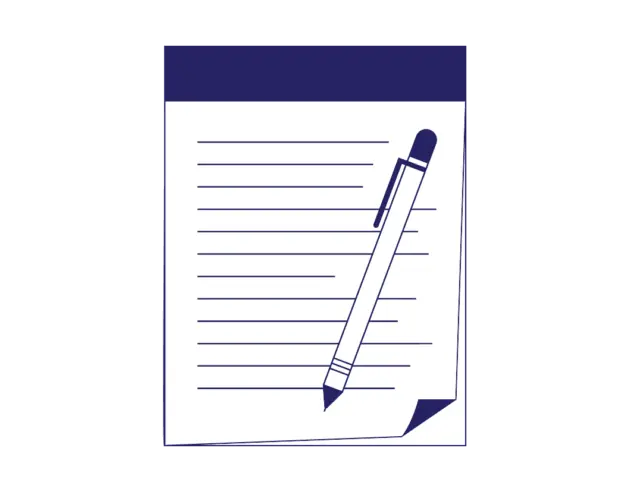
- 3-minute read
- 27th October 2023
You’ve spent hours researching and writing a compelling argumentative essay – now it’s finally time to write the conclusion. The conclusion may be the most significant part of your essay because it’s your final opportunity to make a lasting impression on your reader. Intimidated? Don’t be! In this post, we’ll show you how to write a strong conclusion for an argumentative essay.
Restate the Thesis and Summarize the Key Points
Begin by reiterating your thesis statement to emphasize your main point. However, to avoid sounding repetitive, it’s best to paraphrase the thesis and not use the exact wording from the introductory paragraph. You can also briefly recap the key points you’ve made throughout your essay. You don’t need to dive into too much detail here; the conclusion should be a concise reminder of your most critical arguments and avoid unnecessary repetition or commentary. Keep in mind that the conclusion is not the place to provide information or arguments you haven’t included in the body of your essay.
Emphasize the Significance of Your Arguments
The conclusion of your essay is a good place to highlight the importance of your argument and the implications of your findings. Briefly explain why your essay topic is significant and how your perspective relates to the wider context. For example, if you’re writing on the rising cost of medicine, you can discuss how this topic relates to the broader fields of health care and pharmaceutical sales.
Briefly Address Counterarguments
If you’ve discussed counterarguments in your essay, briefly acknowledge them in the conclusion. You can simply mention that although there are opposing views, you’ve supported your argument with the evidence presented in your essay.
Find this useful?
Subscribe to our newsletter and get writing tips from our editors straight to your inbox.
Maintain a Consistent Tone
Keep the tone of your conclusion consistent with the rest of the essay. For example, if your essay has been primarily formal and academic, maintain that tone in the conclusion (e.g., avoid closing with an informal anecdote or a witty observation).
End With a Thought-Provoking Statement
End your conclusion with a thought-provoking statement or call to action . This could involve a recommendation or prediction, or you could pinpoint areas for further research or action related to the topic. For example, if your topic is the impact of technology on education, you could end your essay by recommending further research into the long-term effects of technology use on students beyond elementary school.
Ensure that your arguments take center stage by having our expert team proofread your essay. Our editors have experience with a wide variety of academic subjects and can ensure that your words make an impact. Send in your sample for free today to see for yourself!
Share this article:
Post A New Comment

Got content that needs a quick turnaround? Let us polish your work. Explore our editorial business services.
6-minute read
How to Write a Nonprofit Grant Proposal
If you’re seeking funding to support your charitable endeavors as a nonprofit organization, you’ll need...
9-minute read
How to Use Infographics to Boost Your Presentation
Is your content getting noticed? Capturing and maintaining an audience’s attention is a challenge when...
8-minute read
Why Interactive PDFs Are Better for Engagement
Are you looking to enhance engagement and captivate your audience through your professional documents? Interactive...
7-minute read
Seven Key Strategies for Voice Search Optimization
Voice search optimization is rapidly shaping the digital landscape, requiring content professionals to adapt their...
4-minute read
Five Creative Ways to Showcase Your Digital Portfolio
Are you a creative freelancer looking to make a lasting impression on potential clients or...
How to Ace Slack Messaging for Contractors and Freelancers
Effective professional communication is an important skill for contractors and freelancers navigating remote work environments....

Make sure your writing is the best it can be with our expert English proofreading and editing.
Reference management. Clean and simple.
How to write an excellent thesis conclusion [with examples]

Restate the thesis
Review or reiterate key points of your work, explain why your work is relevant, a take-away for the reader, more resources on writing thesis conclusions, frequently asked questions about writing an excellent thesis conclusion, related articles.
At this point in your writing, you have most likely finished your introduction and the body of your thesis, dissertation, or research paper . While this is a reason to celebrate, you should not underestimate the importance of your conclusion. The conclusion is the last thing that your reader will see, so it should be memorable.
A good conclusion will review the key points of the thesis and explain to the reader why the information is relevant, applicable, or related to the world as a whole. Make sure to dedicate enough of your writing time to the conclusion and do not put it off until the very last minute.
This article provides an effective technique for writing a conclusion adapted from Erika Eby’s The College Student's Guide to Writing a Good Research Paper: 101 Easy Tips & Tricks to Make Your Work Stand Out .
While the thesis introduction starts out with broad statements about the topic, and then narrows it down to the thesis statement , a thesis conclusion does the same in the opposite order.
- Restate the thesis.
- Review or reiterate key points of your work.
- Explain why your work is relevant.
- Include a core take-away message for the reader.
Tip: Don’t just copy and paste your thesis into your conclusion. Restate it in different words.
The best way to start a conclusion is simply by restating the thesis statement. That does not mean just copying and pasting it from the introduction, but putting it into different words.
You will need to change the structure and wording of it to avoid sounding repetitive. Also, be firm in your conclusion just as you were in the introduction. Try to avoid sounding apologetic by using phrases like "This paper has tried to show..."
The conclusion should address all the same parts as the thesis while making it clear that the reader has reached the end. You are telling the reader that your research is finished and what your findings are.
I have argued throughout this work that the point of critical mass for biopolitical immunity occurred during the Romantic period because of that era's unique combination of post-revolutionary politics and innovations in smallpox prevention. In particular, I demonstrated that the French Revolution and the discovery of vaccination in the 1790s triggered a reconsideration of the relationship between bodies and the state.
Tip: Try to reiterate points from your introduction in your thesis conclusion.
The next step is to review the main points of the thesis as a whole. Look back at the body of of your project and make a note of the key ideas. You can reword these ideas the same way you reworded your thesis statement and then incorporate that into the conclusion.
You can also repeat striking quotations or statistics, but do not use more than two. As the conclusion represents your own closing thoughts on the topic , it should mainly consist of your own words.
In addition, conclusions can contain recommendations to the reader or relevant questions that further the thesis. You should ask yourself:
- What you would ideally like to see your readers do in reaction to your paper?
- Do you want them to take a certain action or investigate further?
- Is there a bigger issue that your paper wants to draw attention to?
Also, try to reference your introduction in your conclusion. You have already taken a first step by restating your thesis. Now, check whether there are other key words, phrases or ideas that are mentioned in your introduction that fit into your conclusion. Connecting the introduction to the conclusion in this way will help readers feel satisfied.
I explored how Mary Wollstonecraft, in both her fiction and political writings, envisions an ideal medico-political state, and how other writers like William Wordsworth and Mary Shelley increasingly imagined the body politic literally, as an incorporated political collective made up of bodies whose immunity to political and medical ills was essential to a healthy state.
Tip: Make sure to explain why your thesis is relevant to your field of research.
Although you can encourage readers to question their opinions and reflect on your topic, do not leave loose ends. You should provide a sense of resolution and make sure your conclusion wraps up your argument. Make sure you explain why your thesis is relevant to your field of research and how your research intervenes within, or substantially revises, existing scholarly debates.
This project challenged conventional ideas about the relationship among Romanticism, medicine, and politics by reading the unfolding of Romantic literature and biopolitical immunity as mutual, co-productive processes. In doing so, this thesis revises the ways in which biopolitics has been theorized by insisting on the inherent connections between Romantic literature and the forms of biopower that characterize early modernity.
Tip: If you began your thesis with an anecdote or historical example, you may want to return to that in your conclusion.
End your conclusion with something memorable, such as:
- a call to action
- a recommendation
- a gesture towards future research
- a brief explanation of how the problem or idea you covered remains relevant
Ultimately, you want readers to feel more informed, or ready to act, as they read your conclusion.
Yet, the Romantic period is only the beginning of modern thought on immunity and biopolitics. Victorian writers, doctors, and politicians upheld the Romantic idea that a "healthy state" was a literal condition that could be achieved by combining politics and medicine, but augmented that idea through legislation and widespread public health measures. While many nineteenth-century efforts to improve citizens' health were successful, the fight against disease ultimately changed course in the twentieth century as global immunological threats such as SARS occupied public consciousness. Indeed, as subsequent public health events make apparent, biopolitical immunity persists as a viable concept for thinking about the relationship between medicine and politics in modernity.
Need more advice? Read our 5 additional tips on how to write a good thesis conclusion.
The conclusion is the last thing that your reader will see, so it should be memorable. To write a great thesis conclusion you should:
The basic content of a conclusion is to review the main points from the paper. This part represents your own closing thoughts on the topic. It should mainly consist of the outcome of the research in your own words.
The length of the conclusion will depend on the length of the whole thesis. Usually, a conclusion should be around 5-7% of the overall word count.
End your conclusion with something memorable, such as a question, warning, or call to action. Depending on the topic, you can also end with a recommendation.
In Open Access: Theses and Dissertations you can find thousands of completed works. Take a look at any of the theses or dissertations for real-life examples of conclusions that were already approved.

Mastering Your Argumentative Essay Conclusion: Tips & Techniques
Table of contents
- 1.1 Steps to Writing an Argumentative Essay Conclusion
- 2 How to Restate a Thesis Statement
- 3.1 Know how to structure your paper
- 4.1 Example 1
- 4.2 Example 2
- 4.3 Example 3
- 4.4 Examples 4, 5
- 5 How to Finish an Argumentative Project Conclusion Paragraph
Want to write a perfect conclusion for your paper but don’t know how? Everyone has been there, and it’s never easy. It is the final part of your writing, so by the time you reach it, you have no energy and can’t focus.
Still, the conclusion part is crucial for the success of every paper. You have to give the final answer to the audience by restating your thesis and noting your claims and findings. If you think you can’t write one, you’d better buy an argumentative essay online and solve your problems.
In this article, you will find everything you need to know about a conclusion to an argumentative essay and how to write it.
What to Write in the Conclusion for an Argumentative Essay
To write a conclusion argumentative essay, you first need to recall all the key points of your essay.
Except for those basic points, knowing how to conclude an argumentative essay also requires a few more things:
The first thing to pay attention to is your tone of writing. Make sure it is authoritative yet calm and informative. This way, you will assure readers that your work is essential for the case.
Next is your first sentence. How you start your conclusion does matter. You need to state what you did and why. That will remind the readers once again about what they have read.
After you write it, you will need to point out the key findings of your writing. You must note the important evidence you have written about in your paper. Keep it brief and connect them to your text conclusion.
The last step is to finish the conclusion of your argumentative essay in a meaningful way. Ensure a positive final sentence to make the reader reflect on your work and make them act.
Thus, writing a conclusion for an argumentative essay is a complex process. It can be not easy to come up with a good conclusion on your own, so don’t hesitate to seek essay assistance if you need it.
Author Note: Make sure not to present any new arguments or claims in the conclusion. This section of your paper is your final opinion. Writing further details, ideas, or irrelevant findings can ruin the text.
Steps to Writing an Argumentative Essay Conclusion
Your conclusion should convincingly summarize your viewpoint. Here’s a simplified way to approach it:
- Briefly restate the importance of your topic.
- Summarize your thesis statement again.
- Acknowledge opposing views to strengthen your argument.
- Suggest actions to be taken or hint at further exploration.
How to Restate a Thesis Statement
- Choose the Right Location:
Place your restated thesis statement where it fits best. Often, it works well at the start of the conclusion, but not always. First, draft a rough conclusion to find the ideal spot. Consider opening with a rhetorical question instead, depending on your paper’s structure.
- Leverage Your Paper’s Content:
Use the full context of your paper to enhance your thesis restatement. Now that your readers have the full information, you can deepen the impact of your argument.
- Clarify the Significance:
Address why your argument matters. Answer the “So what?” question by linking back to the broader implications of your thesis.
- Avoid Common Clichés:
Start your conclusion without clichéd phrases like “In conclusion” or “As this paper has shown.” These phrases can undermine the strength of your restatement.
- Maintain Confidence:
Assert your thesis confidently without hedging with phrases like “It seems like.” However, recognize opposing views respectfully to avoid alienating your readers.
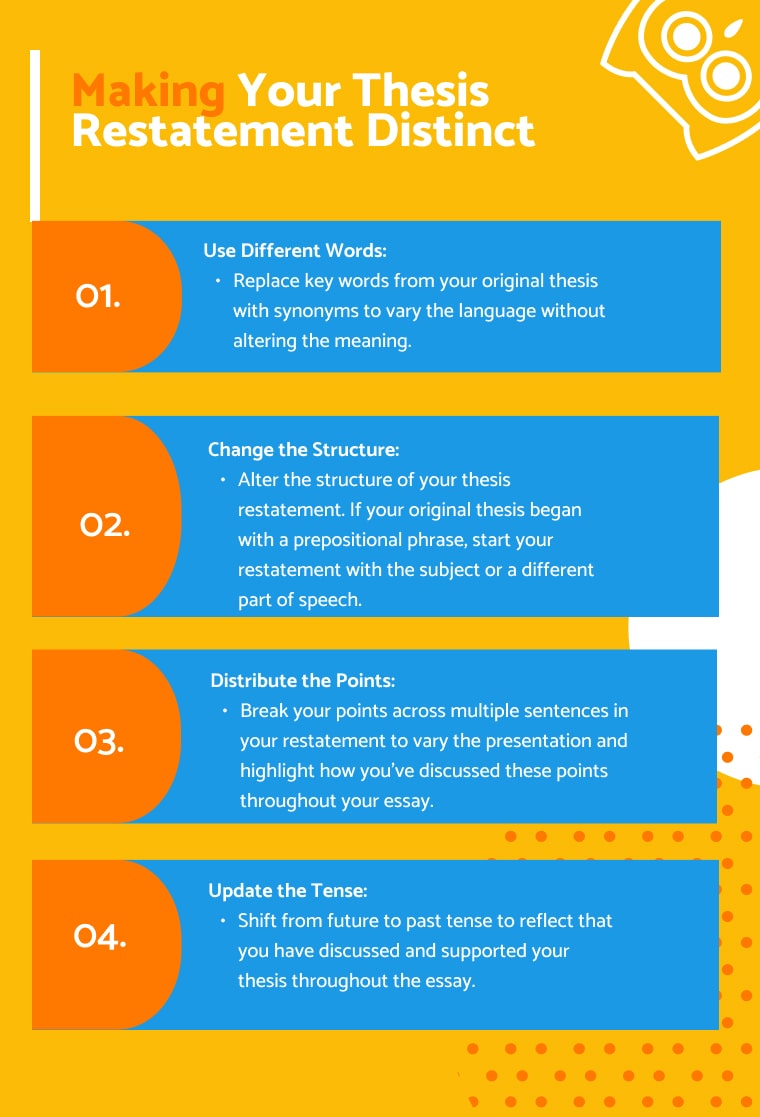
How to Format the Conclusion of an Argumentative Essay?
To format a conclusion, you have to follow a well-established standard. The best essay conclusions include a “lead” (opening statement). Then point out one vital factor from your paragraph. Usually, one point per paragraph, no more, or it will get too bulky. Finally, add an appropriate finale that will serve as a smooth exit of the whole paper, the final sentence.
By using the standard format, you will have an easier time when you have to write an argumentative essay conclusion. You can focus on the facts and tailor them to appeal to readers. That will re-convince them about your point for the case.
Here we can add that the final sentence should not always be smooth and friendly. When your conclusion tone is assertive, write the final part of the finale as a call to action—an attempt to affect the reader and make them want to research. To find out more about the matter or even take a stand with their own opinion.
Know how to structure your paper
- 12-point Times New Roman
- 0″ between paragraphs
- 1″ margin all around
- double-spaced (275 words/page) / single-spaced (550 words/page)
- 0.5″ first line of a paragraph
Knowing the exact way to structure a conclusion in an argumentative essay is crucial. Someone may say that it is not important. But this is one of the first things people pay attention to. So, you have to format the paper and its main points properly. In any assignment, the style of the text adheres to strict requirements. Usually, you can find them by asking your professor or checking the educational institution’s website.
In that sense, you must stick to proper formatting when writing a perfect argumentative essay . To get the best grade, you have to use the recommended formatting style , which can be APA, AP, or other. So remember, following the proper structure and formatting can make the critical points of your work stand out. As a result, your paper will look better, and your paper results will score higher.
Writing a perfect conclusion for your paper can be difficult, especially when you have no energy and can’t focus. Fortunately, PapersOwl.com is here to help. Our experienced writers can provide you with an excellent conclusion for your paper so that you can confidently submit it.

Essay Conclusion Examples
If you are still trying to figure out what your conclusion should look like, check below. We have prepared how-to-end argumentative essay examples . These can give you an idea about the structure and format of your paper’s final point.
In this particular sample, the case is about global warming. So, the essay’s conclusion has to give a compelling reason why the reader and the public should act and prevent the issue. You must remember that what you write depends on the type of paper and should be unique.
“Throughout our text, we pointed out findings about the impact of global warming. Nature cannot sustain itself in the ever-changing climate. The ice caps melt, and the shorelines deteriorate, thus causing the extinction of both flora and fauna. Due to the persisting crisis, we must take action and use the best methods to protect the future of our planet.”
Some papers involve public policies and morals. In such cases, you must write in a tone that will feel morally right but will support and justify your arguments. Usually, you write such papers when your topic is pointing towards persuasion. Below, you can see an argumentative essay conclusion example for such texts.
“As time goes on, technology has changed how we, as a society, receive and use information. Media’s influence has been increasing throughout the social applications we use daily. The said impacts public opinion, as we can see from the participants in our study group. Most have stated that their primary information source is social media. These media get large funds from private entities to filter your content. This way, you see their ideas and become part of their audience. If you like your news free of filtering and want truthful information, you must act now and ensure your rights.”
At one point or another, you will get an assignment to help with your career objectives. Usually, it is connected to your writing as you have to research specific matters. For example, bring out your point of view and make conclusions. You can quickly implement such tasks in essays like the argumentative one. Thus, you have to be ready to write a conclusion of an argumentative essay that can fit well and is decisive.
“Often, when you get the opportunity to launch a new business, you must grab it. Plan business meetings, solve the x, y, and z obstacles, and speed up the process. Business is about profit, producing more revenue, and creating an easily manageable structure. If you choose to act on a different undertaking, there will be risks a or b, which can lead to overstepping the estimated budgets.”
- Free unlimited checks
- All common file formats
- Accurate results
- Intuitive interface
Examples 4, 5
As seen, the conclusion of an argumentative essay may reflect your moral choices. In other cases, on a figure of speech and even sensitivity towards an issue.
So, some good argumentative essay topics need an emotional appeal to the reader. It’s important to present your views effectively and respectfully. But, no matter your point, it is crucial to state your ideas without offending anyone else.
“The right to give birth or not is fundamental for women. They must have it ensured. Otherwise, they have no control or option in their social relationships. The analysis showcases how an unwanted pregnancy can influence and determine the life of a young woman and her child. So without guaranteed rights, women are forced to use dangerous methods to retake ownership of their body, and that must change.” “Life is not a choice given by someone. It is a fundamental right guaranteed by the law. In that sense, denying an unborn child’s right to life is identical to denying any other person’s rights. Furthermore, studies have long proven that life begins with its inception. Therefore, carrying out policies of pro-choice is like murder. With that in mind, saving the unborn by speaking out for them is like giving their rights a voice.”
How to Finish an Argumentative Project Conclusion Paragraph
How to end an argumentative essay? A strong conclusion is key. The final sentence should deeply impact your reader, often ending smoothly yet with a call to action that compels them to think or act. In other cases, the call to action is intense. It could be smoother, but its main goal is to influence the audience to contemplate and act.
It should look like, “ If we don’t do it now, we won’t be able to act in the future. ” If your sentence cuts the flow of the whole text, it will not appeal to your reader. If you are having trouble crafting the perfect conclusion for your argumentative essay, you can always pay for essay help from a professional writer to get the job done right.
Now you understand how to write a conclusion for an argumentative essay, but remember to catch up on the whole paper flow and finish it in the same tone. Use the call to action sentence and exit your essay smoothly while giving the readers ideas and making them think about the case. If you can’t, please check our argumentative essay writing services , which can easily tackle the task. Note that by getting it done by a professional, you can learn from examples. Besides, the text can get done in a few hours.

Readers also enjoyed

WHY WAIT? PLACE AN ORDER RIGHT NOW!
Just fill out the form, press the button, and have no worries!
We use cookies to give you the best experience possible. By continuing we’ll assume you board with our cookie policy.

Essay Conclusion
Essay conclusion generator.

Captivating your readers until the very end is a crucial goal in essay writing. The conclusion holds the power to leave a lasting impression, reinforcing your arguments and providing a sense of closure. In this article, we will delve into the art of crafting essay conclusions that resonate with your audience. Whether you’re a student seeking guidance or a seasoned writer in search of inspiration, this comprehensive guide will equip you with the tools to master the art of concluding your essays effectively.
1. Argumentative Essay Conclusion
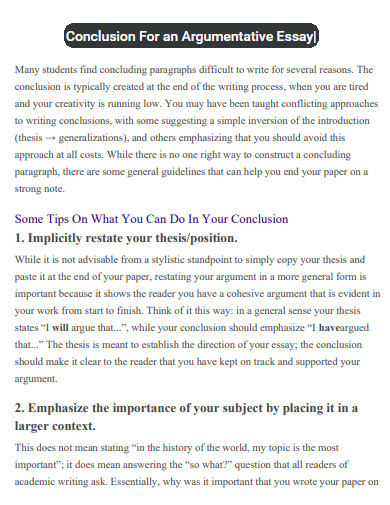
Size: 110 KB
2. University Essay Conclusion
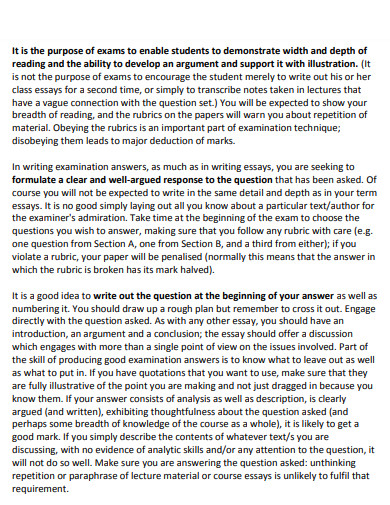
Size: 857 KB
3. Essay Conclusion Structure
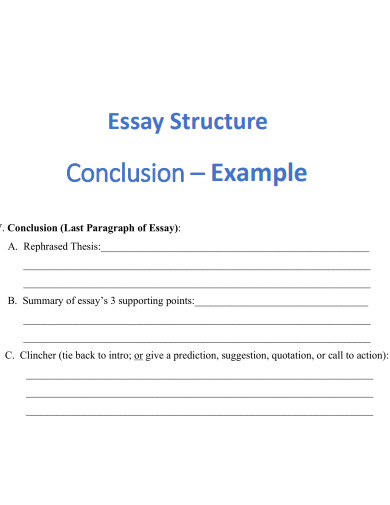
Size: 529 KB
4. English Essay Conclusion
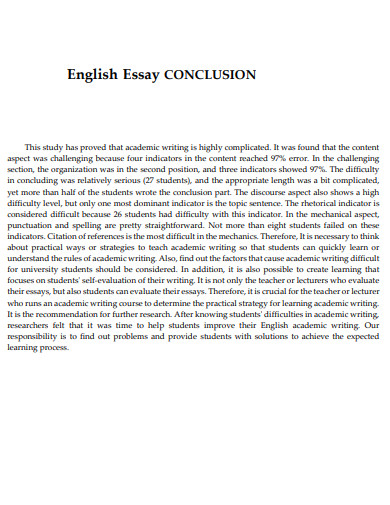
Size: 507 KB
5. Essay Paragraph Conclusion
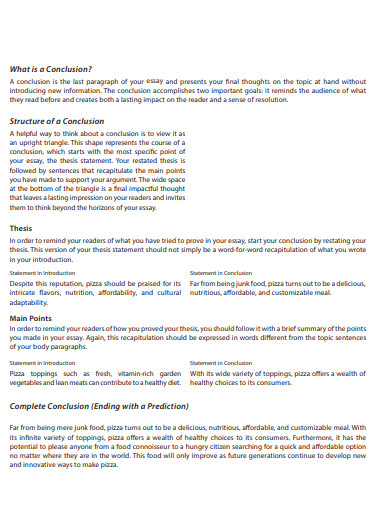
Size: 66 KB
6. Essay on Mental Health Conclusion
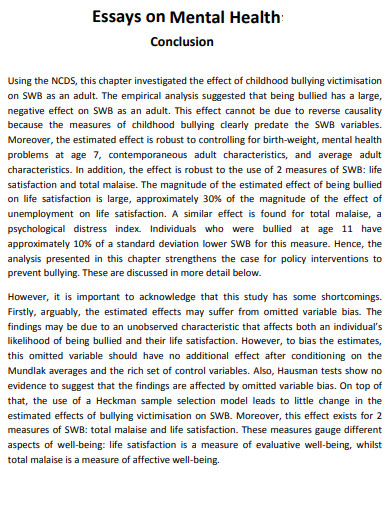
7. Essay on Research Conclusion
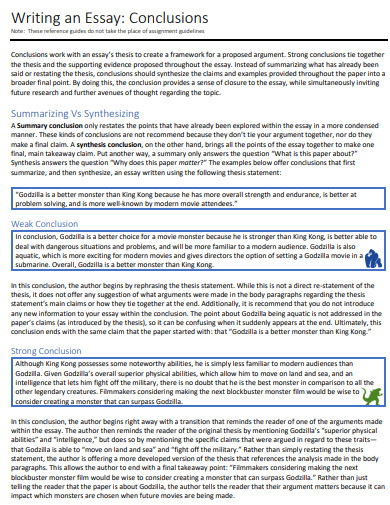
Size: 668 KB
8. Social Media Essay Conclusion
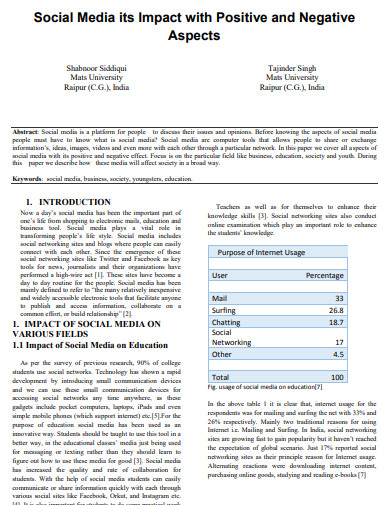
Size: 220 KB
9. Education Essay Conclusion
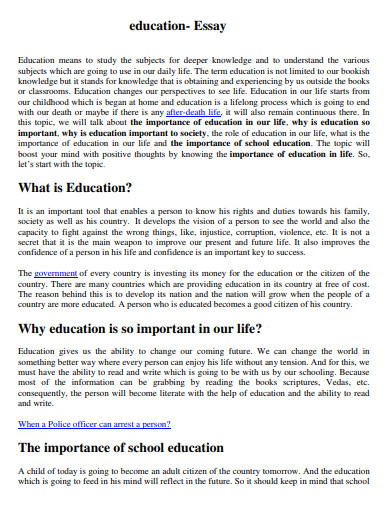
Size: 42 KB
10. Essay Conclusion Sentence
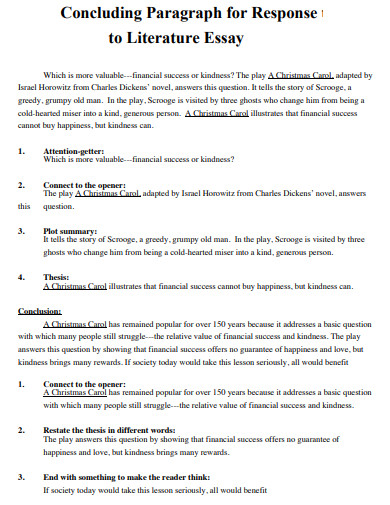
Size: 58 KB
11. Call to Action Essay Conclusion
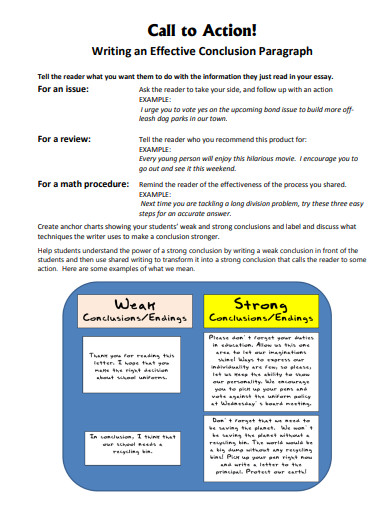
Size: 257 KB
12. Family Essay Conclusion
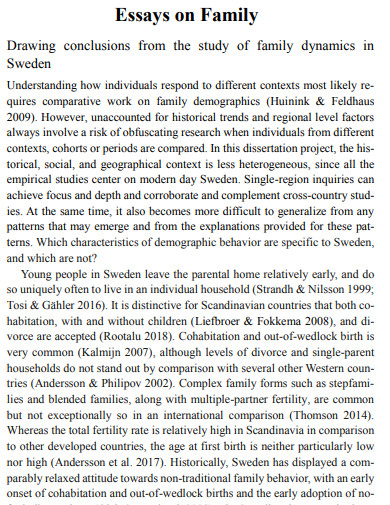
Size: 728 KB
13. Thesis Essay Conclusion
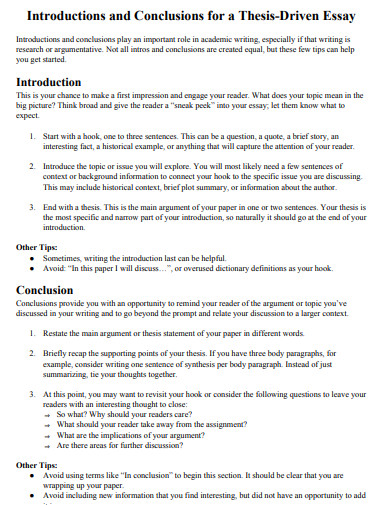
Size: 158 KB
14. Romeo and Juliet Essay Conclusion
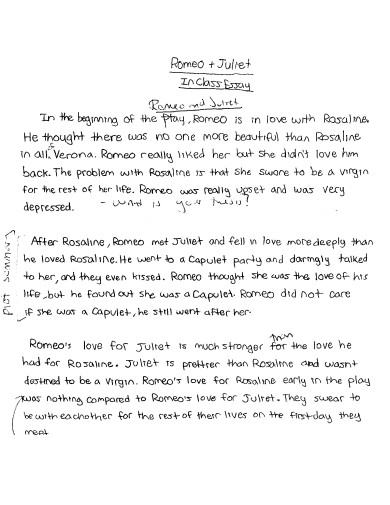
Size: 103 KB
15. Air Pollution Essay Conclusion
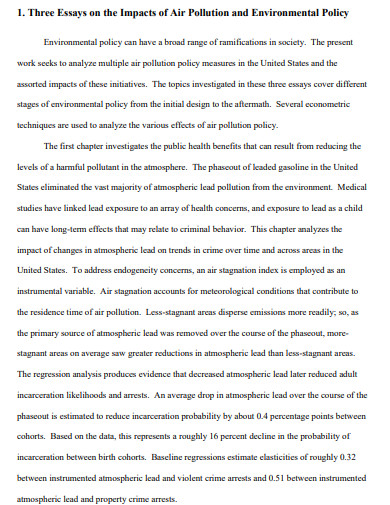
16. Essay Conclusion Template
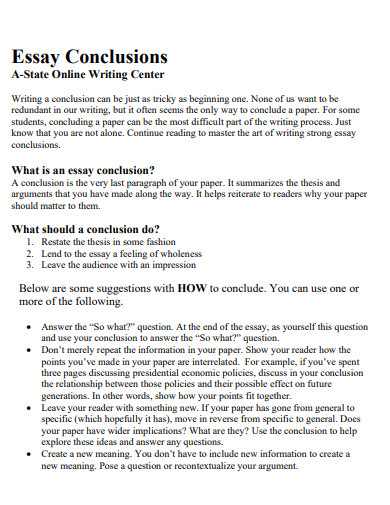
Size: 148 KB
17. Essay Conclusion Example
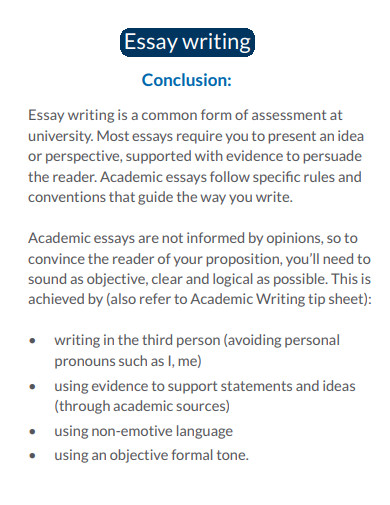
Size: 120 KB
18. Academic Essay Conclusion
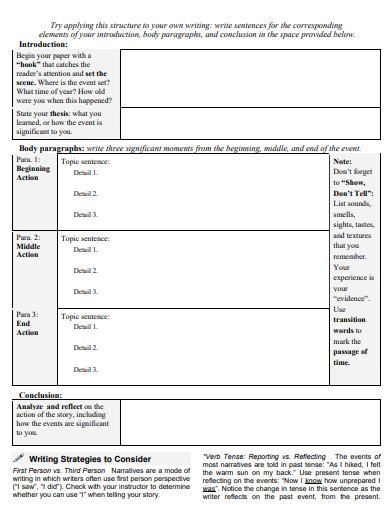
Size: 72 KB
19. Informative Essay Conclusion
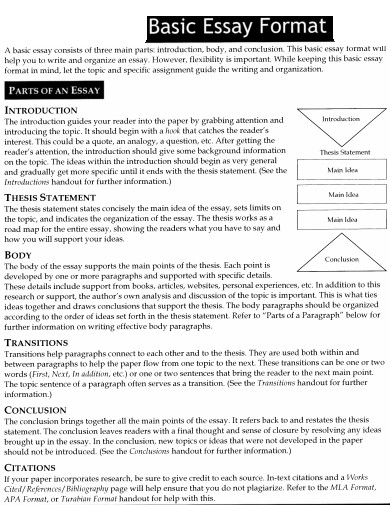
Size: 151 KB
20. Music Essay Conclusion
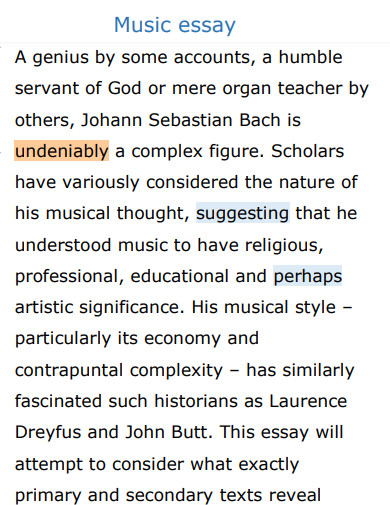
Size: 566 KB
21. 4th Grade Essay Conclusion
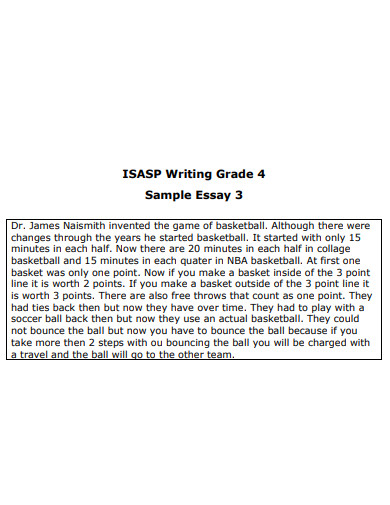
Size: 584 KB
22. 6th Grade Essay Conclusion
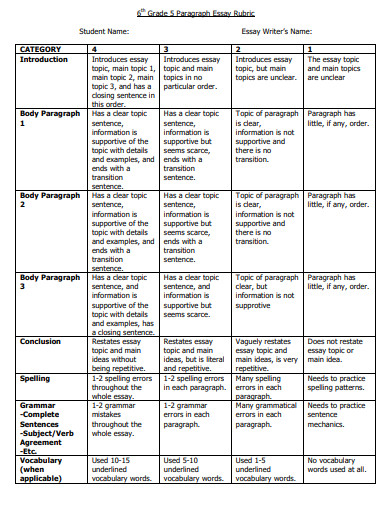
Size: 22 KB
23. Essay on Technology Conclusion
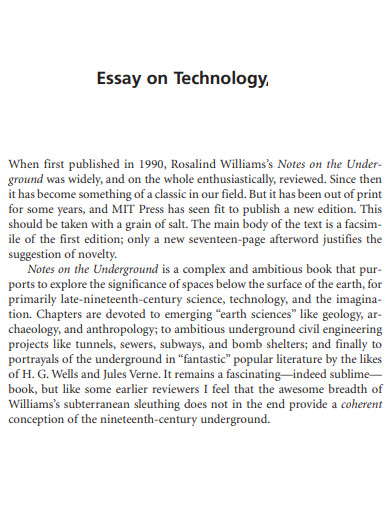
Size: 46 KB
24. Communication Essay Conclusion

Size: 494 KB
25. Deforestation Essay Conclusion
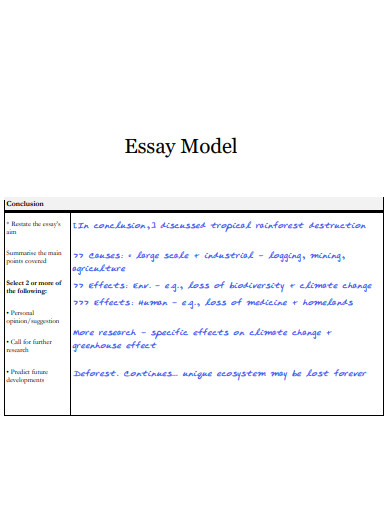
Size: 188 KB
26. Business Essay Conclusion
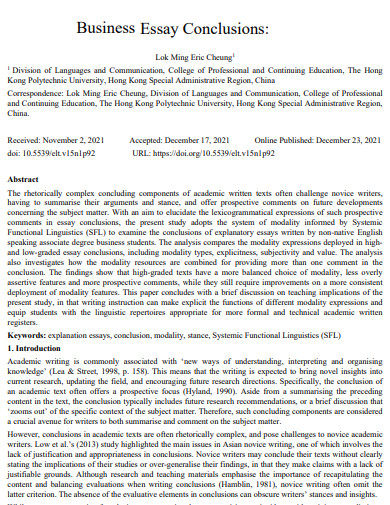
Size: 283 KB
27. Planning Guide Essay Conclusion

Size: 182 KB
28. Basic Essay Conclusion
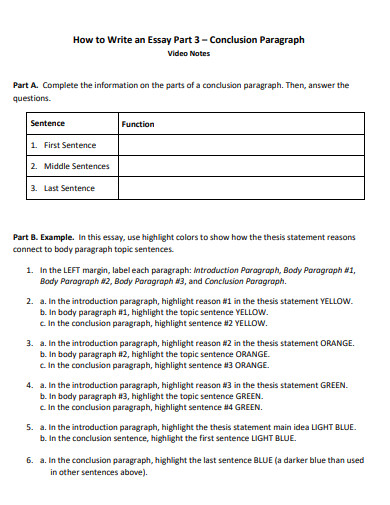
Size: 123 KB
29. Leadership Essay Conclusion
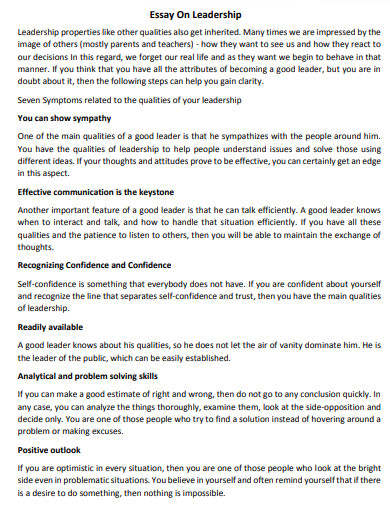
Size: 194 KB
30. Standard Essay Conclusion
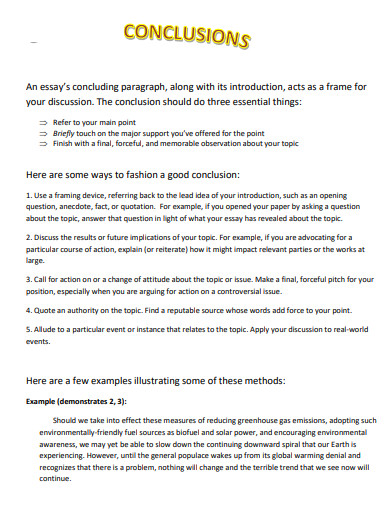
Size: 276 KB
What is an Essay Conclusion?
An essay conclusion serves as the final segment of your written composition. It brings together all the ideas, arguments, and evidence presented throughout the essay and synthesizes them into a concise and coherent final statement. Think of it as the grand finale that encapsulates your main points and leaves a lasting impression on your readers.
How to Write an Essay Conclusion
To create a compelling essay conclusion, follow these step-by-step guidelines
Step 1: Restate your thesis:
Begin by restating your thesis statement, reminding readers of the central argument you have been supporting throughout your essay. However, avoid repeating it verbatim. Instead, rephrase it to maintain reader engagement.
Step 2: Summarize your main points:
Provide a succinct summary of the key points and arguments discussed in the body paragraphs. Focus on the most significant aspects while maintaining a logical flow. Avoid introducing new information or ideas at this stage.
Step 3: Emphasize the significance:
Highlight the broader implications of your essay’s topic and the relevance of your arguments in a wider context. Convey the importance of your findings and their potential impact on the subject matter or the reader’s perspective.
Step 4: Evoke emotions:
Create an emotional connection with your readers by emphasizing the significance of your topic or appealing to their values and beliefs. Stirring emotions can leave a lasting impact and make your conclusion more memorable.
Step 5: Offer a call to action or recommendation:
Depending on the nature of your essay, conclude with a call to action or a thoughtful recommendation that encourages readers to consider further action or reflection on the topic. This can inspire them to continue exploring or take specific steps related to the subject matter.
What is the ideal length for an essay conclusion?
The length of an essay conclusion varies depending on the overall length of your essay. As a general guideline, aim for a conclusion that is concise yet comprehensive, spanning approximately 10-15% of your total essay length.
Can I introduce new information in my essay conclusion?
Avoid introducing new information or arguments in your conclusion. Instead, focus on summarizing and reinforcing the ideas already presented, providing a sense of closure to your essay.
How can I make my essay conclusion more impactful?
To make your essay conclusion more impactful, strive for clarity, emotional resonance, and a sense of closure. Utilize strong language, vivid imagery, and rhetorical devices to leave a lasting impression on your readers.
Just as every book needs a captivating ending to satisfy its readers, your essay deserves a conclusion that lingers in the minds of your audience. By employing the strategies discussed here, you can transform your essay conclusions into thought-provoking reflections, leaving your readers with a sense of fulfillment and a desire to explore your ideas further.
If you’re hungry for more examples and guidance, here are some related articles to inspire you:
- Dive into the world of narratives with 26+ Narrative Essay Examples in PDF .
- Explore the diverse realm of collage essays with 20+ College Essay Examples .
- Enhance your analytical skills with 4+ Interview Analysis Essay Examples in PDF .
- Master concise reporting with 11+ Short Report Essay Examples .
- Uncover the secrets of academic writing with 4+ Short Academic Essay Examples .
- Understand the essay text structure to elevate your writing.
- Delve into self-reflection with 7+ Self Evaluation Essay Examples in PDF .
- Craft persuasive arguments with an Argument Essay .
- For a comprehensive understanding of essay writing, refer to 21+ Essay Writing Examples in PD F.
Remember, the conclusion is your final chance to leave a lasting impact on your readers. Mastering the art of essay conclusions will undoubtedly elevate your writing and captivate your audience. So, go forth and craft memorable endings that resonate with the hearts and minds of your readers.
Text prompt
- Instructive
- Professional
Write an essay conclusion on the future of space exploration.
Develop an essay conclusion on the long-term effects of the internet on human cognition.

Essays and Short Answer Prompts
The Penn application process includes a personal essay —which is sent to most schools you apply to—as well as a few short answer prompts . We read your words carefully, as they are yet another window into how you think, what you value, and how you see the world. Through your writing, we get a glimpse of what you might bring to our community—including your voice and creativity.
Remember, you are the expert on your story. This is an opportunity for you to reflect and understand who you are now, and who you want to be in the future. You have the agency to choose the information you want to share. This is your story: your experiences, your ideas, your perspective.
A Few Writing Tips
- Review the prompts thoroughly. Be sure you’re answering the question or prompt being asked. Topics are chosen because the Admissions Committee wants to know specific things about you. If you don’t address them directly, we are left to make decisions regarding your application with incomplete information.
- Consider your response carefully. We understand that you may be writing responses for different schools and you may want to reuse material, but be sure to read through your response to make sure it is relevant to the prompt.
- Double-check your writing. Give yourself time to revisit your response. Try to avoid rushing your writing process so you have time to revise your work. Ultimately, it is up to you to polish and proofread your writing before you submit.
- Do your research. Are there classes you’re eager to take? Research opportunities you’d love to pursue? A group or club you want to be a part of? This kind of specificity shows us you’re serious about Penn and have thought about how you’d spend your time here.
2023-24 Short Answer and Essay Prompts
When answering these prompts, be precise when explaining both why you are applying to Penn and why you have chosen to apply to that specific undergraduate school. Some of our specialized programs will have additional essays to complete, but the Penn short answer prompts should address your single-degree or single-school choice.
- Write a short thank-you note to someone you have not yet thanked and would like to acknowledge. (We encourage you to share this note with that person, if possible, and reflect on the experience!) (150-200 words, not required for transfer applicants)
- How will you explore community at Penn? Consider how Penn will help shape your perspective, and how your experiences and perspective will help shape Penn. (150-200 words)
- The school-specific prompt is unique to the school to which you are applying. (For example, all applicants applying to the College of Arts and Sciences will respond to the prompt under the “College of Arts and Sciences” section). Considering the undergraduate school you have selected for your single-degree option, please respond to your school-specific prompt below.
Transfer Essay (required for all transfer applicants): Please explain your reasons for transferring from your current institution and what you hope to gain by transferring to another institution. (4150 characters)
Undergraduate School-Specific Short Answer Prompts
For students applying to coordinated dual-degree and specialized programs, please answer this question about your single-degree school choice; your interest in the coordinated dual-degree or specialized program may be addressed through the program-specific essay.
Penn Nursing intends to meet the health needs of society in a global and multicultural world by preparing its students to impact healthcare by advancing science and promoting equity. What do you think this means for the future of nursing, and how do you see yourself contributing to our mission of promoting equity in healthcare? (150-200 words)
To help inform your response, applicants are encouraged to learn more about Penn Nursing’s mission and how we promote equity in healthcare . This information will help you develop a stronger understanding of our values and how they align with your own goals and aspirations.
The flexible structure of The College of Arts and Sciences’ curriculum is designed to inspire exploration, foster connections, and help you create a path of study through general education courses and a major. What are you curious about and how would you take advantage of opportunities in the arts and sciences? (150-200 words)
To help inform your response, applicants are encouraged to learn more about the academic offerings within the College of Arts and Sciences . This information will help you develop a stronger understanding of how the study of the liberal arts aligns with your own goals and aspirations.
Wharton prepares its students to make an impact by applying business methods and economic theory to real-world problems, including economic, political, and social issues. Please reflect on a current issue of importance to you and share how you hope a Wharton education would help you to explore it. (150-200 words)
To help inform your response, applicants are encouraged to learn more about the foundations of a Wharton education . This information will help you better understand what you could learn by studying at Wharton and what you could do afterward.
Penn Engineering prepares its students to become leaders in technology, by combining a strong foundation in the natural sciences and mathematics, exploration in the liberal arts, and depth of study in focused disciplinary majors. Please share how you hope to explore your engineering interests at Penn. (150-200 words)
To help inform your response, applicants are encouraged to learn more about Penn Engineering and its mission to prepare students for global leadership in technology . This information will help you develop a stronger understanding of academic pathways within Penn Engineering and how they align with your goals and interests.
Coordinated Dual Degree and Specialized Program Essay Prompts
For students applying to coordinated dual-degree and specialized programs, please answer the program-specific essay below.
** Numbers marked with double asterisks indicate a character count that only applies to transfer students applying through Common App.
Why are you interested in the Digital Media Design (DMD) program at the University of Pennsylvania? (400-650 words / 3575 characters**)
We encourage you to learn more about the DMD: Digital Media Design Program .
The Huntsman Program supports the development of globally minded scholars who become engaged citizens, creative innovators, and ethical leaders in the public, private, and non-profit sectors in the United States and internationally. What draws you to a dual-degree program in business and international studies, and how would you use what you learn to contribute to a global issue where business and international affairs intersect? (400-650 words)
The LSM program aims to provide students with a fundamental understanding of the life sciences and their management with an eye to identifying, advancing, and implementing innovations. What issues would you want to address using the understanding gained from such a program? Note that this essay should be distinct from your single degree essay. (400-650 words)
- Explain how you will use the M&T program to explore your interest in business, engineering, and the intersection of the two. (400-650 words)
- Describe a problem that you solved that showed leadership and creativity. (250 words)
Describe your interests in modern networked information systems and technologies, such as the internet, and their impact on society, whether in terms of economics, communication, or the creation of beneficial content for society. Feel free to draw on examples from your own experiences as a user, developer, or student of technology. (400-650 words / 3575 characters**)
Discuss your interest in nursing and health care management. How might Penn's coordinated dual-degree program in nursing and business help you meet your goals? (400-650 words)
How do you envision your participation in the Vagelos Integrated Program in Energy Research (VIPER) furthering your interests in energy science and technology? Please include any past experiences (ex. academic, research, or extracurricular) that have led to your interest in the program. Additionally, please indicate why you are interested in pursuing dual degrees in science and engineering and which VIPER majors are most interesting to you at this time. (400-650 words)
- +44 (0) 207 391 9032
Recent Posts
How to write an effective essay outline, how to write a law essay: a comprehensive guide with examples.
- What Are the Limitations of ChatGPT?
- How to Properly Write an Essay Outline Using ChatGpt
- Why Presentation Skills Are Important for Students
- Tips on How to Make an Essay Longer
- How to Structure Your Dissertation in 2024
- How to Write a Research Paper Like a Pro
- Academic Integrity vs. Academic Dishonesty: Understanding the Key Differences
- How to Use AI to Enhance Your Thesis
- Academic News
- Custom Essays
- Dissertation Writing
- Essay Marking
- Essay Writing
- Essay Writing Companies
- Model Essays
- Model Exam Answers
- Oxbridge Essays Updates
- PhD Writing
- Significant Academics
- Student News
- Study Skills
- University Applications
- University Essays
- University Life
- Writing Tips

Since 2006, Oxbridge Essays has been the UK’s leading paid essay-writing and dissertation service
We have helped 10,000s of undergraduate, Masters and PhD students to maximise their grades in essays, dissertations, model-exam answers, applications and other materials. If you would like a free chat about your project with one of our UK staff, then please just reach out on one of the methods below.
Let's put it this way: if you are studying law, you will agree that writing a law essay is no easy feat. Whether you’re dealing with case law, statutes, or legal principles, structuring your essay correctly and presenting your arguments effectively are key to achieving a high grade. This guide will walk you through the essentials of writing a law essay, including structure, introduction examples, and practical tips to help you produce a first-class essay.
A Law Essay Structure
What is the basic structure of a law essay? A well-structured essay not only presents your arguments clearly but also demonstrates your grasp of legal concepts. Here’s a typical structure for a law essay:
Introduction
Overview : Briefly introduce the topic and outline the key issues. Thesis Statement : Clearly state your main argument or position. Purpose : Indicate how the essay will address the issues and what the reader can expect.
Issue Identification : Clearly identify and explain the legal issues or questions. Legal Analysis : Discuss relevant case law, statutes, and legal principles. Argument Development : Develop your arguments logically, providing evidence and analysis to support your points. Counterarguments : Consider and address potential counterarguments or alternative viewpoints.
Summary : Recap the main points and arguments. Reinforcement : Restate your thesis in light of the evidence presented. Final Thoughts : Offer any final reflections or implications of your analysis.
Crafting an Effective Introduction
The introduction of a law essay sets the tone for the rest of your work. A strong introduction should provide a clear overview of the topic and establish the context for your argument. Here’s how you can structure it:
- Hook : Start with an engaging statement or question related to the topic. This could be a relevant quote, a brief anecdote, or a provocative question.
- Context : Provide background information to help the reader understand the relevance of the topic.
- Thesis Statement : Clearly outline your main argument or position. This should guide the direction of your essay.
- Roadmap : Briefly outline how you will address the issues and structure your argument.
Example of a Law Essay Introduction:
“The principle of judicial review is a cornerstone of the British legal system, ensuring that all public authorities act within their legal boundaries. This essay explores the scope and limits of judicial review, focusing on recent judicial decisions that have reshaped its application. By analysing key case law and statutory developments, this essay will argue that while judicial review remains a vital check on executive power, recent trends indicate a shift towards more restrained judicial intervention. The discussion will be organised into three main sections: an examination of the historical development of judicial review, an analysis of contemporary judicial approaches, and an evaluation of the implications for future judicial oversight.”
Writing the Body of the Essay
The body of your law essay is where you provide detailed analysis and develop your arguments. Follow these steps to ensure clarity and depth in your writing:
- Identify the Issues : Clearly define the legal issues or questions at hand. This section should set the foundation for your analysis.
- Provide Legal Analysis : Discuss relevant case law, statutes, and legal principles. Be sure to provide brief summaries of relevant cases, discuss any statutes or legislative provisions relevant to the topic and explain any key legal principles or doctrines that apply to the issues.
- Develop Your Arguments : Present your arguments logically, using evidence and analysis to support your points. Ensure that each paragraph transitions smoothly to the next, maintaining a clear and coherent flow.
- Address Counterarguments : Consider potential counterarguments or alternative viewpoints. Address these within your essay to demonstrate a comprehensive understanding of the topic.
Example of Argument Development
“In the landmark case of R (on the application of Miller) v. Secretary of State for Exiting the European Union (2017), the UK Supreme Court reaffirmed the principle that significant constitutional changes require parliamentary approval. The court’s decision highlighted the importance of maintaining parliamentary sovereignty in the face of executive decisions. However, recent judicial trends suggest a cautious approach towards intervening in political matters, reflecting a broader shift towards judicial restraint. This shift raises questions about the future scope of judicial review and its role in holding the executive accountable.”
Crafting a Strong Conclusion
Your conclusion should summarise the key points discussed and reinforce your thesis. Avoid introducing new information; instead, focus on synthesising your arguments and providing a final perspective. Keep in mind the following:
- Summarise Main Points : Briefly recap the key issues and arguments presented in the body.
- Restate Thesis : Reaffirm your thesis statement, demonstrating how it has been supported by your analysis.
- Final Thoughts : Offer any concluding reflections or implications. This could include suggestions for further research or practical implications of your findings.
Example of a Law Essay Conclusion:
“In conclusion, while the principle of judicial review continues to serve as a crucial mechanism for ensuring accountability, recent developments indicate a more nuanced approach by the judiciary. The balance between maintaining judicial oversight and respecting the limits of judicial intervention is delicate. As demonstrated through recent case law and statutory changes, the evolving nature of judicial review reflects broader shifts in constitutional theory and practice. Future developments will likely continue to shape the scope and application of judicial review, underscoring the need for ongoing scholarly and judicial attention.”
Final Tips for Writing a Law Essay
- Use clear and precise language to convey your arguments. Avoid jargon and overly complex sentences.
- Ensure all claims and arguments are well-supported by legal evidence and analysis.
- Always edit and proofread your essay for clarity, coherence, and correctness. Ensure that your writing adheres to legal academic standards.
Read some complete law essay examples here.
Final Remarks
Writing a law essay involves understanding the structure, crafting an effective introduction, developing your arguments, and presenting a clear conclusion. By following the guidelines and examples provided, you can create a well-organised and compelling essay. Remember, the quality of your analysis and the clarity of your arguments are key to achieving a first-class result.

Essay exams: how to answer ‘To what extent…’

How to write a master’s essay

Writing Services
- Essay Plans
- Critical Reviews
- Literature Reviews
- Presentations
- Dissertation Title Creation
- Dissertation Proposals
- Dissertation Chapters
- PhD Proposals
- Journal Publication
- CV Writing Service
- Business Proofreading Services
Editing Services
- Proofreading Service
- Editing Service
- Academic Editing Service
Additional Services
- Marking Services
- Consultation Calls
- Personal Statements
- Tutoring Services
Our Company
- Frequently Asked Questions
- Become a Writer
Terms & Policies
- Fair Use Policy
- Policy for Students in England
- Privacy Policy
- Terms & Conditions
- [email protected]
- Contact Form
Payment Methods
Cryptocurrency payments.

How to Write a Research Proposal: (with Examples & Templates)

Table of Contents
Before conducting a study, a research proposal should be created that outlines researchers’ plans and methodology and is submitted to the concerned evaluating organization or person. Creating a research proposal is an important step to ensure that researchers are on track and are moving forward as intended. A research proposal can be defined as a detailed plan or blueprint for the proposed research that you intend to undertake. It provides readers with a snapshot of your project by describing what you will investigate, why it is needed, and how you will conduct the research.
Your research proposal should aim to explain to the readers why your research is relevant and original, that you understand the context and current scenario in the field, have the appropriate resources to conduct the research, and that the research is feasible given the usual constraints.
This article will describe in detail the purpose and typical structure of a research proposal , along with examples and templates to help you ace this step in your research journey.
What is a Research Proposal ?
A research proposal¹ ,² can be defined as a formal report that describes your proposed research, its objectives, methodology, implications, and other important details. Research proposals are the framework of your research and are used to obtain approvals or grants to conduct the study from various committees or organizations. Consequently, research proposals should convince readers of your study’s credibility, accuracy, achievability, practicality, and reproducibility.
With research proposals , researchers usually aim to persuade the readers, funding agencies, educational institutions, and supervisors to approve the proposal. To achieve this, the report should be well structured with the objectives written in clear, understandable language devoid of jargon. A well-organized research proposal conveys to the readers or evaluators that the writer has thought out the research plan meticulously and has the resources to ensure timely completion.
Purpose of Research Proposals
A research proposal is a sales pitch and therefore should be detailed enough to convince your readers, who could be supervisors, ethics committees, universities, etc., that what you’re proposing has merit and is feasible . Research proposals can help students discuss their dissertation with their faculty or fulfill course requirements and also help researchers obtain funding. A well-structured proposal instills confidence among readers about your ability to conduct and complete the study as proposed.
Research proposals can be written for several reasons:³
- To describe the importance of research in the specific topic
- Address any potential challenges you may encounter
- Showcase knowledge in the field and your ability to conduct a study
- Apply for a role at a research institute
- Convince a research supervisor or university that your research can satisfy the requirements of a degree program
- Highlight the importance of your research to organizations that may sponsor your project
- Identify implications of your project and how it can benefit the audience
What Goes in a Research Proposal?
Research proposals should aim to answer the three basic questions—what, why, and how.
The What question should be answered by describing the specific subject being researched. It should typically include the objectives, the cohort details, and the location or setting.
The Why question should be answered by describing the existing scenario of the subject, listing unanswered questions, identifying gaps in the existing research, and describing how your study can address these gaps, along with the implications and significance.
The How question should be answered by describing the proposed research methodology, data analysis tools expected to be used, and other details to describe your proposed methodology.
Research Proposal Example
Here is a research proposal sample template (with examples) from the University of Rochester Medical Center. 4 The sections in all research proposals are essentially the same although different terminology and other specific sections may be used depending on the subject.

Structure of a Research Proposal
If you want to know how to make a research proposal impactful, include the following components:¹
1. Introduction
This section provides a background of the study, including the research topic, what is already known about it and the gaps, and the significance of the proposed research.
2. Literature review
This section contains descriptions of all the previous relevant studies pertaining to the research topic. Every study cited should be described in a few sentences, starting with the general studies to the more specific ones. This section builds on the understanding gained by readers in the Introduction section and supports it by citing relevant prior literature, indicating to readers that you have thoroughly researched your subject.
3. Objectives
Once the background and gaps in the research topic have been established, authors must now state the aims of the research clearly. Hypotheses should be mentioned here. This section further helps readers understand what your study’s specific goals are.
4. Research design and methodology
Here, authors should clearly describe the methods they intend to use to achieve their proposed objectives. Important components of this section include the population and sample size, data collection and analysis methods and duration, statistical analysis software, measures to avoid bias (randomization, blinding), etc.
5. Ethical considerations
This refers to the protection of participants’ rights, such as the right to privacy, right to confidentiality, etc. Researchers need to obtain informed consent and institutional review approval by the required authorities and mention this clearly for transparency.
6. Budget/funding
Researchers should prepare their budget and include all expected expenditures. An additional allowance for contingencies such as delays should also be factored in.
7. Appendices
This section typically includes information that supports the research proposal and may include informed consent forms, questionnaires, participant information, measurement tools, etc.
8. Citations

Important Tips for Writing a Research Proposal
Writing a research proposal begins much before the actual task of writing. Planning the research proposal structure and content is an important stage, which if done efficiently, can help you seamlessly transition into the writing stage. 3,5
The Planning Stage
- Manage your time efficiently. Plan to have the draft version ready at least two weeks before your deadline and the final version at least two to three days before the deadline.
- What is the primary objective of your research?
- Will your research address any existing gap?
- What is the impact of your proposed research?
- Do people outside your field find your research applicable in other areas?
- If your research is unsuccessful, would there still be other useful research outcomes?
The Writing Stage
- Create an outline with main section headings that are typically used.
- Focus only on writing and getting your points across without worrying about the format of the research proposal , grammar, punctuation, etc. These can be fixed during the subsequent passes. Add details to each section heading you created in the beginning.
- Ensure your sentences are concise and use plain language. A research proposal usually contains about 2,000 to 4,000 words or four to seven pages.
- Don’t use too many technical terms and abbreviations assuming that the readers would know them. Define the abbreviations and technical terms.
- Ensure that the entire content is readable. Avoid using long paragraphs because they affect the continuity in reading. Break them into shorter paragraphs and introduce some white space for readability.
- Focus on only the major research issues and cite sources accordingly. Don’t include generic information or their sources in the literature review.
- Proofread your final document to ensure there are no grammatical errors so readers can enjoy a seamless, uninterrupted read.
- Use academic, scholarly language because it brings formality into a document.
- Ensure that your title is created using the keywords in the document and is neither too long and specific nor too short and general.
- Cite all sources appropriately to avoid plagiarism.
- Make sure that you follow guidelines, if provided. This includes rules as simple as using a specific font or a hyphen or en dash between numerical ranges.
- Ensure that you’ve answered all questions requested by the evaluating authority.
Key Takeaways
Here’s a summary of the main points about research proposals discussed in the previous sections:
- A research proposal is a document that outlines the details of a proposed study and is created by researchers to submit to evaluators who could be research institutions, universities, faculty, etc.
- Research proposals are usually about 2,000-4,000 words long, but this depends on the evaluating authority’s guidelines.
- A good research proposal ensures that you’ve done your background research and assessed the feasibility of the research.
- Research proposals have the following main sections—introduction, literature review, objectives, methodology, ethical considerations, and budget.

Frequently Asked Questions
Q1. How is a research proposal evaluated?
A1. In general, most evaluators, including universities, broadly use the following criteria to evaluate research proposals . 6
- Significance —Does the research address any important subject or issue, which may or may not be specific to the evaluator or university?
- Content and design —Is the proposed methodology appropriate to answer the research question? Are the objectives clear and well aligned with the proposed methodology?
- Sample size and selection —Is the target population or cohort size clearly mentioned? Is the sampling process used to select participants randomized, appropriate, and free of bias?
- Timing —Are the proposed data collection dates mentioned clearly? Is the project feasible given the specified resources and timeline?
- Data management and dissemination —Who will have access to the data? What is the plan for data analysis?
Q2. What is the difference between the Introduction and Literature Review sections in a research proposal ?
A2. The Introduction or Background section in a research proposal sets the context of the study by describing the current scenario of the subject and identifying the gaps and need for the research. A Literature Review, on the other hand, provides references to all prior relevant literature to help corroborate the gaps identified and the research need.
Q3. How long should a research proposal be?
A3. Research proposal lengths vary with the evaluating authority like universities or committees and also the subject. Here’s a table that lists the typical research proposal lengths for a few universities.
| Arts programs | 1,000-1,500 | |
| University of Birmingham | Law School programs | 2,500 |
| PhD | 2,500 | |
| 2,000 | ||
| Research degrees | 2,000-3,500 |
Q4. What are the common mistakes to avoid in a research proposal ?
A4. Here are a few common mistakes that you must avoid while writing a research proposal . 7
- No clear objectives: Objectives should be clear, specific, and measurable for the easy understanding among readers.
- Incomplete or unconvincing background research: Background research usually includes a review of the current scenario of the particular industry and also a review of the previous literature on the subject. This helps readers understand your reasons for undertaking this research because you identified gaps in the existing research.
- Overlooking project feasibility: The project scope and estimates should be realistic considering the resources and time available.
- Neglecting the impact and significance of the study: In a research proposal , readers and evaluators look for the implications or significance of your research and how it contributes to the existing research. This information should always be included.
- Unstructured format of a research proposal : A well-structured document gives confidence to evaluators that you have read the guidelines carefully and are well organized in your approach, consequently affirming that you will be able to undertake the research as mentioned in your proposal.
- Ineffective writing style: The language used should be formal and grammatically correct. If required, editors could be consulted, including AI-based tools such as Paperpal , to refine the research proposal structure and language.
Thus, a research proposal is an essential document that can help you promote your research and secure funds and grants for conducting your research. Consequently, it should be well written in clear language and include all essential details to convince the evaluators of your ability to conduct the research as proposed.
This article has described all the important components of a research proposal and has also provided tips to improve your writing style. We hope all these tips will help you write a well-structured research proposal to ensure receipt of grants or any other purpose.
References
- Sudheesh K, Duggappa DR, Nethra SS. How to write a research proposal? Indian J Anaesth. 2016;60(9):631-634. Accessed July 15, 2024. https://www.ncbi.nlm.nih.gov/pmc/articles/PMC5037942/
- Writing research proposals. Harvard College Office of Undergraduate Research and Fellowships. Harvard University. Accessed July 14, 2024. https://uraf.harvard.edu/apply-opportunities/app-components/essays/research-proposals
- What is a research proposal? Plus how to write one. Indeed website. Accessed July 17, 2024. https://www.indeed.com/career-advice/career-development/research-proposal
- Research proposal template. University of Rochester Medical Center. Accessed July 16, 2024. https://www.urmc.rochester.edu/MediaLibraries/URMCMedia/pediatrics/research/documents/Research-proposal-Template.pdf
- Tips for successful proposal writing. Johns Hopkins University. Accessed July 17, 2024. https://research.jhu.edu/wp-content/uploads/2018/09/Tips-for-Successful-Proposal-Writing.pdf
- Formal review of research proposals. Cornell University. Accessed July 18, 2024. https://irp.dpb.cornell.edu/surveys/survey-assessment-review-group/research-proposals
- 7 Mistakes you must avoid in your research proposal. Aveksana (via LinkedIn). Accessed July 17, 2024. https://www.linkedin.com/pulse/7-mistakes-you-must-avoid-your-research-proposal-aveksana-cmtwf/
Paperpal is a comprehensive AI writing toolkit that helps students and researchers achieve 2x the writing in half the time. It leverages 21+ years of STM experience and insights from millions of research articles to provide in-depth academic writing, language editing, and submission readiness support to help you write better, faster.
Get accurate academic translations, rewriting support, grammar checks, vocabulary suggestions, and generative AI assistance that delivers human precision at machine speed. Try for free or upgrade to Paperpal Prime starting at US$19 a month to access premium features, including consistency, plagiarism, and 30+ submission readiness checks to help you succeed.
Experience the future of academic writing – Sign up to Paperpal and start writing for free!
Related Reads:
- How to Paraphrase Research Papers Effectively
- How to Cite Social Media Sources in Academic Writing?
- What is the Importance of a Concept Paper and How to Write It
APA format: Basic Guide for Researchers
You may also like, how to choose a dissertation topic, how to write a phd research proposal, how to write an academic paragraph (step-by-step guide), five things authors need to know when using..., 7 best referencing tools and citation management software..., maintaining academic integrity with paperpal’s generative ai writing..., research funding basics: what should a grant proposal..., how to write an abstract in research papers..., how to write dissertation acknowledgements.
How do you write an argumentative essay? i have to do an essay on the Colombian exchange so help
Information is used, but it is organized based on these major components of an argument:
Claim, Reason, Evidence, Counter-Claim, and Rebuttal.
What are you trying to prove of argue.
It is provided to support a claim.
It is used to support a reason; they can be statistics, facts, quotations or surveys.
Counter-Claim:
Opposing position, counterargument.
Disproves the counterclaim; addresses the criticism of the claim.
YOU CAN ALSO ASK YOURSELF THESE QUESTIONS FOR EVEN SIMPLER WRITING..........:
Claim : What do I think?
Reason : Why do I think it?
Evidence : How do I know (proof)?
Counterclaim : What is the other side?
Rebuttal : My response to the other side?
Related Questions
ASAP HELP!!! pls be accurate!!!!! how does the word miraculous in the first paragraph help set the tone of the passage.
Explanation:
It is number 2.
Hope this helps!! Please give brainlist!
can somebody help me with this please its language arts
Sweeping open the heavy doors of the library, Maria felt the rush of cool air. Grandpa had always called the library the best travel agent that existed. Slowly, Maria was beginning to be convinced. Going to the library reminded Maria of the way an airplane climbs at take-off. That feeling of flight was thrilling, especially without the nervous "butterflies" in her stomach that she got with real airplanes. Instead, she smiled broadly, excited about what might be in store for her. Where should I travel to today? she thought to herself. Last week, she had visited famous presidents' faces, carved into huge stone layers. Mount Rushmore was a place that had always interested her. How could they have done that? Who created them in the first place? And why? Not only did the library serve as a wonderful travel agent, it also played the part of historian and highly knowledgeable tour guide. Her "tour book" had answered all of her questions and explained all of the curious details she could dream up—and so much more. She also enjoyed being able to leisurely stroll down aisles upon aisles of books. She could stop and look at any one of them that caught her attention. Today, she started with Africa, but then she stopped herself. "Why do I have to start with the A's? Why does it always have to be in order or make sense? I'm on vacation." "Why not throw caution to the wind?" Grandpa would say when he wanted her to try something new or different. So she turned around and headed toward the opposite end of the shelves. "Oh, the Z's. That's certainly different," she said. The first book spine that caught her eye was a bold, sparkling gold print. It read "Zimbabwe." Maria laughed to herself. Somehow, she had ended up in Africa anyway. Maybe that's where she needed to travel to today. As she flipped through the thick pages full of colorful fabrics, stark landscapes, and wild animals, she was quickly convinced that Zimbabwe would be her trek for the day. Maria carried the book to the checkout counter. Renee, the librarian, smiled as she read the title. "Ah, Zimbabwe! That's someplace I've always wanted to visit." "Well, you can go there as soon as I return from my trip," Maria said. Renee laughed and winked, knowing all about Maria's travels. "Yes, I will, Maria. You'll have to tell me all about it when you return. Bon voyage!" Maria was eager to talk to Grandpa about this one. Sometimes, throwing caution to the wind brings you right back to where you began in the first place. 8 How does Maria's grandfather advise her in this story? A. He tells her to plan adventures by following library clues. B. He reminds her to be creative and open to new ideas. C. He teaches her to be kind and respectful of other ways of living. D. He explains there is a chance to learn things every day.
B: He reminds her to be creative and open to new ideas.
In the passage it states that Maria's grandfather would say "throw caution into the wind" which usually means try something new, thats what leads me to believe the answer you need is B. Hope this helps :)
Explain the importance of teamwork. Then, provide an example of a time in which you worked with a team and there was a positive benefit. Explain in detail. 1 paragraph
Teamwork is a very important thing when it comes to big or large tasks. You can split things up between each other. It can always lighten up the load. I know this becuase when my friends or I have a story that we have trouble on. We go to each other and we split up the chapters or the characters or whatever part we are having trouble with. It always makes things easier and helps us make the deadline we have for are selves or the actual deadline.
I hope this helps
HELPP AND HURRY Which example best shows how speeches can be interactive?
A is the correct answer!
this is for religion and I need helpppp
Baptism- Immersion in water that symbolizes being reborn and sometimes admission into a Christian Church.
Confirmation- The sacrament in which Catholics receive an outpouring of the Holy Spirit. Through Confirmation, the Holy Spirit gives them a better ability to practice their faith in every aspect of their lives and to be able to see God in all situations.
Eucharist- Holy communion in which bread and wine representing the flesh and blood of Christ are consumed
Penance- An action done out of repentance
Anointing of the sick- The putting of oil on one's forehead often when sick or near death for one to receive physical and spiritual health. Also done when one is not sick and might just need spiritual and physical health.
Marriage- Marriage which is called holy matrimony is a man and woman establishing a partnership between them for the rest of their life.
Holy orders- (These are the holy orders: Baptism, confirmation, eucharist, penance, anointing of the sick, marriage.) The ones who do certain holy orders are Pope, bishop, cardinal, and priest.(These are the four ranks of those who perform holy orders)
Where did sacraments originate and why are they important to the Catholic faith? Christ told his disciples to administer and receive each of the sacraments. Sacraments make people holy and build the body of Christ.
I hope this helps most of it I searched up and got help from someone to answer. I hope you pass whatever you are doing. May God be with you.
Question 4(Multiple Choice Worth 5 points) (LC) When an author uses a fable with a moral to present a message, what is the most likely purpose? A To inform B To entertain C To persuade D To teach
which statement best describes the authors style in this poem
formal and wondrous
It best describes it because it is ordered in a formal way and its full of wonder.
How is the structure in the introduction [paragraphs 1-3] different from the structure in the section "Greek myths were like daytime TV soap operas"?
Part A What is a theme developed in this scene from Pygmalion? For some, there are other things in life more valuable than money. Success is often possible with persistence. Complimenting people may make them more agreeable. It is unwise to expect something for nothing in return. Question 2 Part B Which detail from the scene best supports the answer in Part A? "Well, here I am ready to pay him—not asking any favor—and he treats me as if I was dirt." "Well, you wouldn't have the face to ask me the same for teaching me my own language as you would for French; so I won't give more than a shilling. Take it or leave it." THE FLOWER GIRL [coming back to him, triumphant] Now you're talking! I thought you'd come off it when you saw a chance of getting back a bit of what you chucked at me last night. [Confidentially] You'd had a drop in, hadn't you? "HIGGINS. Figure it out. A millionaire has about 150 pounds a day. She earns about half-a-crown. PASSAGE/TEXT IS IN COMMENTS
Success is often possible with persistence
Ok so I'm really behind so I'm giving 20 pts to who gets this correct
I'd probably go for B but if you want an exemplary thesis try D but I suggest B mostly.
Tell me a time you were "going through motions of life".
my motions are never sad actually but I can tell you happy about life or life facts cuz some people be needing dem
ASAP Will choose brainliest!!! (for most accurate answer!) what is the main idea of the passage and choose 2 sentences that together best support the correct answer for part A
Answer:the answer is on part A is 1 and the anwser on part b is 3
Explanation:because trains change the united states
Part B: 1 and 5
Hope this helps! Please give brainlist!!
Select the correct answers. Read the paragraph. What would be the best way to correctly edit the underlined sentence? Music piracy occurs when you share music with friends, such as giving friends a free copy of a song. This behavior may not seem like a big deal, but it can have a huge impact on the music industry. Their is a lot of people working together to create a song, songwriters, audio enginers, computer technicians, producers, recording artists, and more. A study by the Institute for Policy Innovation found that music piracy led to over 70,000 lost jobs and billions of dollars in lost wages. In order to keep your favorite singers in business, it’s important to avoid getting music without paying for it. A. There is a lot of people working together to create a song, songwriters, producers, recording artists, and others. B. There are a lot of people working together to create a song, songwriters, producers, recording artists, and others. C. Their are a lot of people working together to create a song: songwriters, producers, recording artists, and others. D. There are a lot of people working together to create a song, including songwriters, producers, recording artists, and others. E. There is a lot of people working together to create a song, songwriters, producers, recording artists, and others.
Choice D is correct. "There are a lot of people working together to create a song, including songwriters, producers, recording artists, and others."Hope this helps!
Question & Passage is in the pictures. Please help.
ASAP can someone pls answer this sudoku for me, this is due tomorrow morning!!!
PLS help fast!! no bots The first-person point of view in "How I Learned English” helps readers identify the events that lead up to the climax. experience the sights and sounds of the setting. understand what each character thinks and feels. follow the development of the main character.
Ok so I'm behind and I'm giving 20 pts to who gets it correct for me
well there was no question so???
Where is the question?
No one answered cause you didn't put a question
how would this diary entry differ from an autobiographical passage? A) An autobiographical passage is not written in first person perspective. B) There is no substantial difference between a diary entry and an autobiography. C) Diary entries are usually written from a third-person point of view unlike this passage. D) A diary entry is usually written in a more personal, and informal tone than an autobiography.
Read these two sentences, noting how the underlined word creates a transition between them. Luna tilled up a large area of her backyard. Then she pulled out all the clumps of weeds so that she could plant a garden. Which phrase best describes the point of the signal word then as it's used here? Group of answer choices It signals a shift in the story's setting. It builds suspense. It connects two thoughts. It indicates the passage of time.
To get to the airport, you need to take a tram.
I'm writing a paragraph and I'm kinda confused on where I'm supposed to put a comma for this. One example of this is when...
Answer: After "this"
Explanation: When you say "One example of this is when..." you want to pause after "this" to explain what happened. You have more to say, so you are putting a comma to furthermore state your idea.
Question 3(Multiple Choice Worth 5 points) (HC) In which of these situations would an author most likely use a first person narrator? A. A song in which the lyrics speak of long-forgotten friends B. A story that has the purpose of teaching an important lesson C. A compare and contrast article about the work of two organizations D. A narrative in which the author describes personal reactions to an event
Can You Please help Me. Am not doing so good rn and am in a bad mental state please all i beg of you to help :(
The answers will be-
5. Outlined
6. Recommend
7. Approaches
10. Would kiss
because of the brackets given already, it is easy to find the answer.
hope u found it useful!!
How do you think homework makes you achieve?
With the help of homework, students are able to perform better on tests. 78% percentage of students complain about the over-workload but it actually helps them prepare for a test or another upcoming assignment. :)
Work .......... in 1176 and finished in 1183 a) begin b) begun c) began d) begins
Answer: began
Explanation: it's a past action, so we use the past of the verb
Question 8(Multiple Choice Worth 5 points) (HC) I remember breakfasts with my grandfather—our morning toast was my favorite time of day. He would toast bread by placing it right on the center rack of the oven. Then, he would butter the bread on both sides and sprinkle cinnamon sugar over the butter. Finally, he would cut the toast into perfect little squares. I can smell that sweet toast now! What is the one disadvantage of writing this story in the first-person point of view? Readers are not engaged. We know the narrator's thoughts, but not the grandfather's thoughts. We know the grandfather's thoughts, but not the narrator's thoughts. We do not get a firsthand account.
The answer is B .
In first-person narration, the story is written as if the reader is the character (usually the protagonist [the main character]). The only problem with 1st-person narration, is that unlike 3rd-person omnicient (in which we know the thoughts and emotions of multiple and/or all the characters) we only know the thoughts and emotions of one character (the protagonist).
Write three original poems. They can be any combination of Haikus, Cinquains, or Free Verse poems.
/One of my Sonnet poems/
Last Glimpse Of The World
As I lay my head on a bed of rose I feel the piercing wind on my shoulders
And I hope my friends that I dearly love know
‘cause I’m getting more and more tired and older
I see the maple tree’s leaves start to fade
yesterday was just a normal boring day
So let today be the day we remove flowers made
To get to the place that I make my way
I see the sun bright colors turn into a dark luster
I know my time in this world has to end
With the life I worked hard for was clustered
I hope in my after life everything mends
Then I slowly try to let myself go
But it's hard when you tried not that long ago….
Which of the following is not an example of biased language? a. “The chairman will be in shortly.” b. “Give each student his paper as soon as he is finished.” c. “Everyone has a right to his or her opinion.” d. “ Ask the nurse when she returns.”
hope this helps
There are four main types of text structure: 1.___________________: texts describe events in time order. (first, second, next, before) 2.___________________:looks at the similarities and differences between texts. (also, like, both, but) 3.___________________:text explain why events happen and the effect after. (because, so, result) 4.___________________: introduces a problem and presents a possible solution. (issue, resolve) A ______________________ is the use of two negative words in a sentence. Often used in songs and informal language. Includes words such as: do not, don’t, never, not, didn’t.
1. Chronological order
2. Compare and Contrast
3. Cause and Effect
4. Problem and Solution
And the last one I think is called a double negative. Hope I helped . Pls give brainliest if I did helped.
give my man/girl branly
Discuss what you think is happening in the world right now? How do you know? Where do you go for information? What information is being released to the general public and what do you think people are not saying?
the world is scared from the future. because every country is planning for it, but will the future will ever come? no one living his life as today is his last day. i get my information from big speakers. they releasing the good side, the happy one and no one should worry. and people not saying the reality of this world, that nothing lasts.
- Latest Latest
- The West The West
- Sports Sports
- Opinion Opinion
- Magazine Magazine
My church is closing, and I don’t know what comes next — for me, or America
I researched the decline of organized religion while having a front-row view of the change in my own life.

By Ryan Burge
How do you get rid of a pulpit? Or a communion table?
Does anyone want 30-year-old choir robes?
What do you do with the baptismal records of a church that dates back to the 1860s?
I never thought I would be asking myself these questions, but here I am, like many other pastors across the country as the number of Americans who belong to a faith community shrinks and churches that once housed vibrant congregations close.
What’s happened at my own church is especially poignant since in my day job I research trends in American religion. And when I first became a pastor, right out of college, there were ominous signs, but I did not foresee how quickly the end would come, hastened by a pandemic.

I first took the pulpit of First Baptist Church of Mount Vernon, Illinois, in the fall of 2006. The church was a part of the American Baptist denomination, a mainline tradition that welcomed women into leadership and tended to take a more moderate stance on theological and social issues. I was 24 years old, pursuing a master’s degree in political science, and I needed a job that would give me the flexibility to focus on my studies. It seemed like a good fit at the time, both theologically and logistically, although it was inconceivable to me then that I would still hold the same position into my early 40s.
I preached in a sanctuary that could easily accommodate 300 people. That first year or two, I could count about 50 people scattered around the pews. It felt sparse, but not empty — a relief, since I wasn’t the most credentialed pastor in the history of the church. As an undergraduate, I took a couple of classes that focused on theology and ministry, but that was it. I did my best to not say something heretical during my Sunday sermon. What I lacked in education and experience, I was sure I could make up with enthusiasm. There’s an apocryphal quote from John Wesley, the founder of Methodism, that I thought about often in those first couple of years: “Light yourself on fire with passion, and people will come from miles to watch you burn.”
I tried to light that match every Sunday morning. People didn’t show up.
I don’t know if the members of my congregation thought I was going to be the one who turned around the fortunes of the church, but there was lots of talk of growth in those first few hopeful years. Many faithful members had been sitting in those pews for decades. They had seen the church in its heyday, when there were so many people in Sunday School that they had to install movable dividers in the fellowship hall so they could add more classrooms in the 14,000-square-foot building.
But the church’s membership began to dwindle in the 1970s and 1980s. If you talked to five members of my church about this period of time, you would get five different reasons for the decline: An ill-advised sermon drove off a few key families. Lots of kids who grew up in the church went off to college and didn’t return to rural Illinois because of the lack of employment opportunities. Other churches in town seemed more attractive with their drums, guitars and high-energy worship. Regardless of the cause, the membership of First Baptist dipped below 100 by the late 1990s.
After a couple of years, the discussion about revitalizing the church began to grow quiet. A sense of resignation started to creep in. I came to a disheartening conclusion: I wasn’t going to be able to turn things around. I think at that point most members knew in their hearts that the end was coming for the church. We were just all afraid to speak that truth into existence. It was better to keep our heads down and focus on the next worship service and not worry about what would happen in three or five years.

The rise of ‘The Nones’
On one of my first Sundays as pastor, the older adults had invited me to their Sunday School class. We sat around a table with Styrofoam cups of coffee and tried to find common ground across a five-decade generational divide. They were glad to have me, and I was honored that they trusted me enough to be their pastor. About a year ago, I was looking at an old church directory and realized that every person in that classroom back in 2006 had met their eternal reward over the previous 15 years, and I had presided at many of their funerals.
But as my church was dying, my academic career was starting to accelerate. I began to plunge headlong into data about American religion. I had earned a Ph.D. in political science with a dissertation that focused on religion and politics while I held the pulpit at First Baptist, and I had landed a job at a university that was within driving distance of my home base. I could be a professor during the week and pastor on the weekends.
I wrote a couple of academic articles about American religion in an effort to secure my employment in academia, but I didn’t want to produce scholarship that only a dozen or so people in my subfield would read.
So I decided to take the things I was seeing in the data and help the average person understand the changing American religious landscape. I began posting graphs on my Twitter account. Most of them got little attention until I created a simple line graph that traced American religion between 1972 and 2018.
The point was simple: The share of Americans who were nonreligious was now the same size as evangelicals. The post went viral, and the trajectory of my life changed. That graph appeared in nearly every major media outlet in the United States, and it led to me writing a book about the rise of nonreligious Americans, a book entitled “ The Nones .”
What I was seeing in the data was unmistakable and mapped perfectly onto what I was seeing every Sunday — mainline Protestant Christianity was in near free fall, and the numbers of nonreligious were rising every single year. Members of the media found my career combination of pastor and social scientist fascinating. I can’t count the number of times I was asked what it was like to have both jobs. My response was a shrug of the shoulders and the simple statement, “It doesn’t seem odd to me. It’s all I’ve ever known.”
Soon, I was being asked to comment on stories about religion and politics for a number of prominent media outlets. Journalists would thank me for helping provide them with ideas for stories. I was being asked to speak in front of crowds of hundreds of people about the past and future of American religion. When I was asked what motivated me to continue to do this kind of work, all I could say was, “I’m just trying to help other people see the big picture in American religion.”
What I was really trying to do was to convince myself that the rapid decline of my church wasn’t my fault.

A sense of letting people down
I always had a nagging sense that I was never supposed to be a pastor. That I took the job at First Baptist for the wrong reasons. That I didn’t believe enough. That I didn’t try hard enough. That there was a way to revitalize that little congregation in Mount Vernon, but I just wasn’t willing to do the work to make it happen.
I knew I couldn’t say that part that out loud.
While my online platform was rising and I was being offered a variety of opportunities to speak and write, things were continuing to decline at my little church. I would come from home from speaking at a conference that had a couple hundred in attendance to preach before a nearly empty sanctuary on Sunday morning.
The church members decided that it was best for us to move from that giant space to a large classroom in the education wing of the building. We bought a small sound system and set up chairs around a pulpit at the front of the room. Looking back on that time now, it was my favorite period of pastoring at the church. The room was small enough that it felt intimate. When we sang, it filled up the space. Saying “The Lord’s Prayer” together meant so much more when I could hear 20 voices reciting those same lines back at me in unison.
However, there was a looming problem that I would make mention of in our quarterly business meeting and then move on to other matters — we were running out of money.
The building was huge. It was built to accommodate hundreds of worshippers and dozens of Sunday School classes. Many rooms had not been used in decades. We just didn’t need the space anymore. What had once been a point of pride for the church was now little more than an albatross around our necks. The utility bills in winter were larger than my salary. The 40-year-old boiler that heated the church could stop working at any moment.
So with a tremendous amount of trepidation, we decided to put the building on the market. I clearly remember the day that I had to post the information on social media. I felt so ashamed that we had to publicly announce the fact that we couldn’t afford to keep our church home anymore. There were countless members of First Baptist who had donated their time and their labor to construct that building in the 1960s. They had given over and above their tithe to finance the bricks, the carpet and the pews. I couldn’t get over the feeling that I was letting all of them down. I still can’t.
How to sell a church, 101
There is no handbook for how to sell a church building, and none of us were prepared for how exhausting that process would be. One day, I got a call from a real estate developer who was interested in buying the property. While he never said it outright, and I never asked, I realized that his plans included razing the building and using the property for a subdivision or a commercial opportunity. I told him that I appreciated the interest, but I would only be in contact if we had no other options.
We had about a dozen groups tour the property; most never followed up. In the end, we got one cash offer — for $150,000. The pastor said that God had instructed him that they could go no higher. Our church council politely declined. That sum would have made it virtually impossible for us to move to another facility for any period of time. We were getting desperate.
Then we were thrown a bit of a lifeline. Another church in town had started a private Christian school and quickly outgrown their space. They wanted to take over ownership of the building. The details of the agreement were complicated, but the outcome was fairly straightforward: The school would use the building during the week, but we would have access on the weekends for worship. That’s how we continued to exist over the last five years. We had no building to worry about; we could just gather together on Sundays and try to limp along for as long as we wanted. It felt like we had been granted a divine stay of execution.
For a couple of years, we were fine. We would have two dozen people on a good Sunday, enough to make us feel like we were still a congregation. But every six or eight months, we would lose a key member, then another, then another. That two dozen became 15, then 12, then 10. As attendance dwindled, so did our bank accounts. I didn’t need to put together a statistical model to tell my members when the bank balance was going to hit zero. They could do the math.

The last Sunday
I’ve heard several people say that organizations die slowly, then all at once. That’s what happened to us.
At the start of the year, we went four Sundays without meeting. Illness ran through our thinning ranks, and one Sunday the wind chill was below zero, and we knew that our folks didn’t want to get out. When we met again in February, things felt different. We were lucky to get to double digits, and any enthusiasm that existed before had seemed to evaporate. It was time to talk about closing.
After Easter, we held a business meeting, one that had been playing out in my mind for a decade or more. The minutes of that meeting are sparse, taking up just a single piece of paper. There was no discussion of whether we should close or not. We just decided on the logistics.
We picked a date: July 21. That would be the last time that the faithful few of First Baptist of Mount Vernon, a church founded by hardscrabble pioneers in 1868, would gather together to worship.
I am having a hard time wrapping my head around the fact that I get asked all the time, by pastors, denominational leaders and interested observers, about ways to grow a church. I guess people assume that since I spend my days digging through religion data, that I should have been able to uncover the secret to getting people back into religion.
It takes everything in my power to not say to them, “My church went from 50 people to less than 10 under my watch. If I knew anything about how to grow a church I would have done it by now.”
But I know where they are coming from because many of them are in the same boat that I was in. They are watching the waves lap over the side of their rickety vessel every day. The bucket to bail out the water is too small to do any good. Still, thousands of pastors are trying to keep the boat seaworthy by any means necessary, even as more cracks begin to emerge in the hull. They sense that they have a hopeless mission, but believe that God has called them to be faithful, not necessarily successful.
Last Sunday, I stood behind the pulpit of First Baptist Church for the last time.
I asked the people gathered there for prayer requests, and we sang “Happy Birthday” to anyone who is celebrating in the coming weeks. We said the Lord’s Prayer and the Apostles’ Creed together and sang a few favorite hymns along with the Doxology and the Gloria Patri. I stumbled through a sermon that will likely be soon forgotten.
Then, after the hymn of invitation, I raised my hand to the congregation and gave them one final benediction from the book of Numbers:
The Lord bless you
and keep you;
the Lord make his face shine on you
and be gracious to you;
the Lord turn his face toward you
and give you peace.
Then I told them once more, “Go in peace to love and serve your neighbors.” I know that I may never see some of those people ever again.
I walked out those doors into the blinding heat of a summer day in southern Illinois and stepped into a future where I don’t know where I will go to church next Sunday, or even if I want to go. Frankly, I don’t know if my own faith will survive, and I’m not sure if the church in America will be there for the next generation like it was for me.
And I’m terrified because for the first time in my spiritual life, I don’t know what’s next.

Ryan Burge is an associate professor of political science at Eastern Illinois University. He is the author or co-author of four books, including “The Nones,” “20 Myths about Religion and Politics in America” and “The Great Dechurching.” He has written for The New York Times, The Wall Street Journal and Politico, and has appeared on “60 Minutes,” where Anderson Cooper called him “one of the leading data analysts of religion and politics in the United States.” He was the pastor of an American Baptist Church in Illinois for more than 17 years.
Generate Cool Nicknames for Roblox
Start generating cool nicknames for roblox for free below.
If you need help, please refer to the detailed step-by-step instructions entitled below.
Write about
Generate cool nicknames for roblox in these simple steps.
Enter topic
Select language, tone and word count
Click on the Generate button
Introducing WriteCream’s Instant Cool Nicknames for Roblox Generator: Crafting Nicknames with a Single Click
The “Generate Cool Nicknames for Roblox” tool by Writecream is designed to effortlessly create unique and engaging nicknames for Roblox players. With just one click, users can generate a variety of cool nicknames, perfect for standing out in the Roblox community. Whether you’re a seasoned player or new to the game, this tool helps you find the perfect nickname that reflects your personality and style.
How It Works:
- Input Details : Enter your preferences or any specific keywords you want in your nickname.
- Generate : Click the ‘Generate’ button to create a list of cool nicknames.
- Review and Customize : Browse through the generated nicknames, select your favorite, and make any desired customizations.
- Copy and Use : Copy your chosen nickname and start using it in Roblox or share it with friends.
Key Features:
- Personalized Recommendations : The tool takes into account any specific preferences or keywords entered, providing personalized nickname suggestions.
- Nickname Categories : Choose from various categories like cool, funny, edgy, or fantasy to find the perfect match for your style.
- Multiple Language Support : Generate nicknames in different languages, adding a global appeal to your gaming identity.
- Inspiration Board : Get inspired by a board of popular and trending nicknames within the Roblox community.
The “Generate Cool Nicknames for Roblox” tool by Writecream is your go-to solution for finding the perfect nickname effortlessly. Whether you’re looking to refresh your Roblox persona or create a new one, this tool ensures you have the coolest nickname in the game.
Create content in minutes, not weeks.
© Copyright 2024 Writecream | All Rights Reserved
Wait! Before you go...
Sign up to get 10,000 words per month for free, please enter your name and email below:.

IMAGES
VIDEO
COMMENTS
Step 1: Return to your thesis. To begin your conclusion, signal that the essay is coming to an end by returning to your overall argument. Don't just repeat your thesis statement —instead, try to rephrase your argument in a way that shows how it has been developed since the introduction. Example: Returning to the thesis.
Let's go through each step. 1. Understand the Purpose. The conclusion is your final opportunity to leave an impact. It should tie together your main ideas, reinforce your message, and give the reader a sense of closure. Wrap Up Your Main Ideas. The conclusion should succinctly wrap up the main points of your writing.
Highlight the "so what". At the beginning of your paper, you explain to your readers what's at stake—why they should care about the argument you're making. In your conclusion, you can bring readers back to those stakes by reminding them why your argument is important in the first place. You can also draft a few sentences that put ...
Finally, some advice on how not to end an essay: Don't simply summarize your essay. A brief summary of your argument may be useful, especially if your essay is long--more than ten pages or so. But shorter essays tend not to require a restatement of your main ideas. Avoid phrases like "in conclusion," "to conclude," "in summary," and "to sum up ...
In this video, you'll learn how to write a strong essay conclusion paragraph that ties together the essay's main points, shows why your argument matters, and...
End your essay with a call to action, warning, or image to make your argument meaningful. Keep your conclusion concise and to the point, so you don't lose a reader's attention. Do your best to avoid adding new information to your conclusion and only emphasize points you've already made in your essay. Method 1.
Also read: How to Write a Thesis Statement. 2. Tying together the main points. Tying together all the main points of your essay does not mean simply summarizing them in an arbitrary manner. The key is to link each of your main essay points in a coherent structure. One point should follow the other in a logical format.
When wondering how to write a conclusion, it boils down to this: Conclusions should round off the topic and leave a strong impression in the readers' minds. We show you three key elements to a memorable conclusion.
The conclusion allows you to have the final say on the issues you have raised in your paper, to synthesize your thoughts, to demonstrate the importance of your ideas, and to propel your reader to a new view of the subject. It is also your opportunity to make a good final impression and to end on a positive note.
Essay Conclusion Examples. Below is a range of copy-and-paste essay conclusions with gaps for you to fill-in your topic and key arguments. Browse through for one you like (there are 17 for argumentative, expository, compare and contrast, and critical essays). Once you've found one you like, copy it and add-in the key points to make it your own.
Option 4: End on an action. Ending on an action can be a strong way to wrap up your essay. That might mean including a literal action, dialogue, or continuation of the story. These endings leave the reader wanting more rather than wishing the essay had ended sooner. They're interesting and can help you avoid boring your reader.
How to write a conclusion. An effective conclusion is created by following these steps: 1. Restate the thesis. An effective conclusion brings the reader back to the main point, reminding the reader of the purpose of the essay. However, avoid repeating the thesis verbatim. Paraphrase your argument slightly while still preserving the primary point.
A change of style i.e. being more emotional or sentimental than the rest of the essay. Keep it straightforward, explanatory and clear. Overused phrases like: "in conclusion"; "in summary"; "as shown in this essay". Consign these to the rubbish bin! Here are some alternatives, there are many more: The x main points presented here ...
Conclusions. Conclusions wrap up what you have been discussing in your paper. After moving from general to specific information in the introduction and body paragraphs, your conclusion should begin pulling back into more general information that restates the main points of your argument. Conclusions may also call for action or overview future ...
Emphasize the Significance of Your Arguments. The conclusion of your essay is a good place to highlight the importance of your argument and the implications of your findings. Briefly explain why your essay topic is significant and how your perspective relates to the wider context. For example, if you're writing on the rising cost of medicine ...
The conclusion to an essay is the most purely rhetorical part of the entire piece. By "rhetorical", we mean a conclusion's (and indeed the entire essay's) ability to convince or persuade the reader of certain outlooks or arguments. An essay conclusion needs to use rhetoric to emotionally connect with the reader in some way. And this is ...
A good conclusion will review the key points of the thesis and explain to the reader why the information is relevant, applicable, or related to the world as a whole. Make sure to dedicate enough of your writing time to the conclusion and do not put it off until the very last minute. Organize your papers in one place. Try Paperpile.
Example 1. In this particular sample, the case is about global warming. So, the essay's conclusion has to give a compelling reason why the reader and the public should act and prevent the issue. You must remember that what you write depends on the type of paper and should be unique.
Discover the art of crafting captivating essay conclusions that leave a lasting impact. Learn how to restate your thesis, summarize key points, evoke emotions, and offer recommendations. Explore examples and gain valuable insights in this comprehensive guide. Elevate your writing skills with 29+ Essay Conclusion Examples in PDF.
An effective conclusion . ends on a strong note with a call to action. The final sentence should be the "big finish" that leaves the reader with a significant lasting impression. A graphic organizer and a fillable template are provided on the next two pages to help students . visualize the argumentative essay organization.
We understand that you may be writing responses for different schools and you may want to reuse material, but be sure to read through your response to make sure it is relevant to the prompt. Double-check your writing. Give yourself time to revisit your response. Try to avoid rushing your writing process so you have time to revise your work.
Writing a law essay involves understanding the structure, crafting an effective introduction, developing your arguments, and presenting a clear conclusion. By following the guidelines and examples provided, you can create a well-organised and compelling essay.
Q4. What are the common mistakes to avoid in a research proposal?. A4. Here are a few common mistakes that you must avoid while writing a research proposal. 7 . No clear objectives: Objectives should be clear, specific, and measurable for the easy understanding among readers. Incomplete or unconvincing background research: Background research usually includes a review of the current scenario ...
Integrating these creative writing techniques keeps your travel essay lively, clear and compelling from start to finish. So captivate readers with an essay unveiling your travel adventures and ...
Are you preparing for the IELTS exam and want to master writing introductions for IELTS discussion essays? This video is your ultimate guide! We'll walk you ...
Tips When Writing When discussing diversity in medical school application essays , experts say, it's important to reflect on past experiences and accomplishments, and consider what they mean in ...
Select the correct answers. Read the paragraph. What would be the best way to correctly edit the underlined sentence? Music piracy occurs when you share music with friends, such as giving friends a free copy of a song.
After a couple of years, the discussion about revitalizing the church began to grow quiet. A sense of resignation started to creep in. I came to a disheartening conclusion: I wasn't going to be able to turn things around. I think at that point most members knew in their hearts that the end was coming for the church.
Embark on the Future of Essay Writing with WriteCream's Instant Essay Typer. Say good bye to writer's block and welcome a seamless, efficient, and effective approach to crafting outstanding essays with a single click. Let WriteCream effortlessly showcase your ideas in the best possible light.